Ep. 82: Division Chief Kosaku Shima (Kodansha Bilingual Comics), by Kenshi Hirokane
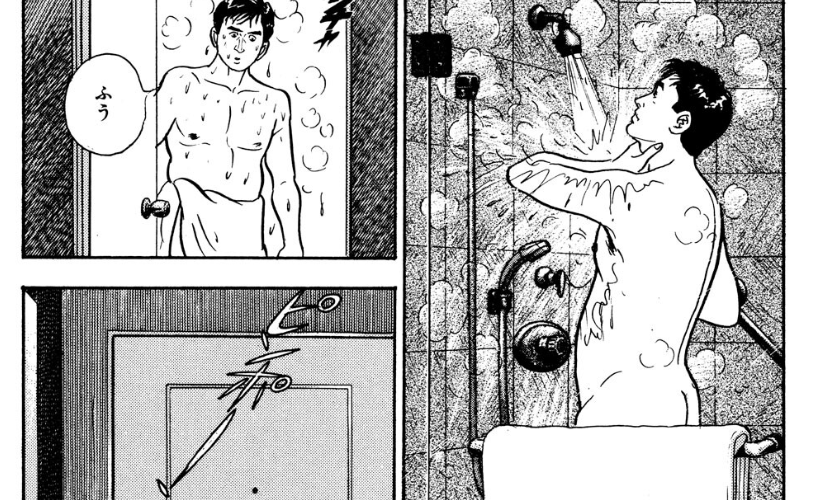
It’s Business Time! We’re back with a new episode and a “new” manga, the dramatic day-in-the-life Division Chief Kosaku Chief. Only published in Japan in a bilingual edition designed to teach and reinforce English language learning among Japanese readers, we got our hands on this Japanese import and deep-dive into the world of Japanese businessmen in the 90s!
Powered by RedCircle
Listen and Subscribe to the Podcast:
Google | Apple | Stitcher | RedCircle | Amazon | Radio Public | PocketCast | Spotify
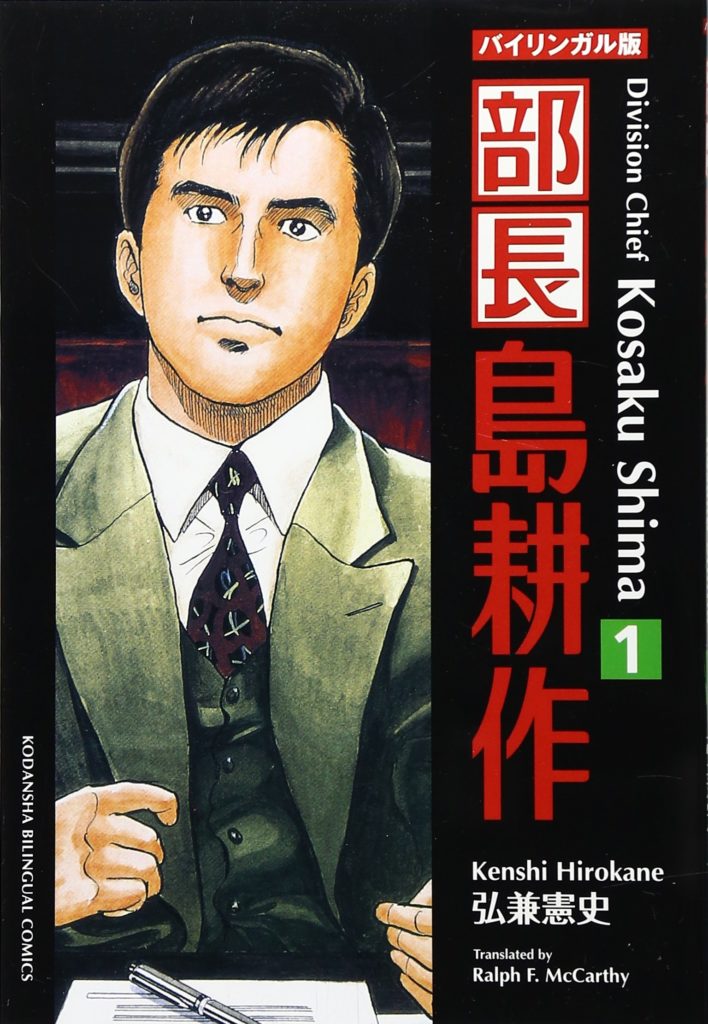
Division Chief Kosaku Shima Volume 1– Kodansha Bilingual Edition
By Kenshi Hirokane
Translated by Ralph F. McCarthy
Published by Kodansha (Japan Only)
ISBN 978-4770026330
Audio editing by David Brothers. Show notes by Christopher Woodrow-Butcher and Deb Aoki
Before We Get Started:
NSFW imagery in these show notes! You’ve been warned.
Hi it’s Christopher. Deb’s on vacation this week, so just me. Sorry for the errors!
Speaking of errors, a side-effect of moving to the other side of the world is recording the podcast first thing in the morning, around 8am, rather than at the end of my work day. So I’m REALLY caffeinated this episode trying to wake up, and talk a hell of a lot during it. It evens out by the end of the episode, but I actually begged off hosting AKIRA and our wrap-up episode for the same reason. I’m not a morning person and this is a four-person podcast, and I need to be more awake and less caffeinated. We’re all learning.
Alright, let’s do this.
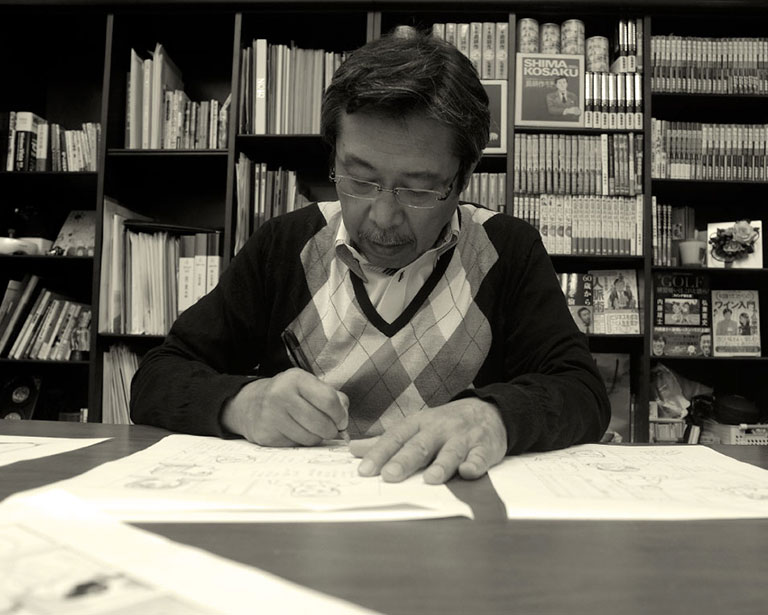
ABOUT KENSHI HIROKANE:
Kenshi Hirokane was born September 9th, 1947, in Iwakuni, Yamaguchi, Japan. He graduated from Waseda University with a degree in law, and then went to work for Matsushita Electric out of school, which would eventually rebrand to the internationally-known electronics brand Panasonic. He worked in the advertising department there, where he would draw illustrations and work on marketing campaigns.
After four years, he left Matsushita Electric and made his manga debut in 1974 with the series Kaze Kaoru. In addition to his life-long project Kosaku Shima, which has been running more-or-less consistently since 1983, he created the best-selling seinen manga series Hello Hedgehog, which was adapted into an anime called Domain of Murder, and was the artist for the manga Human Crossing, which also got an anime adaptation, among other projects. The most notable is perhaps Tasogare Ruseigun, or Like Shooting Stars in Twilight, which Deb mentions this episode. Like Shooting Stars in Twilight has been running since in Shogakukan’s Big Comics Original since 1995, and details middle-aged and elder people living and loving. It’s been adapted into several TV dramas, radio dramas, and movies.
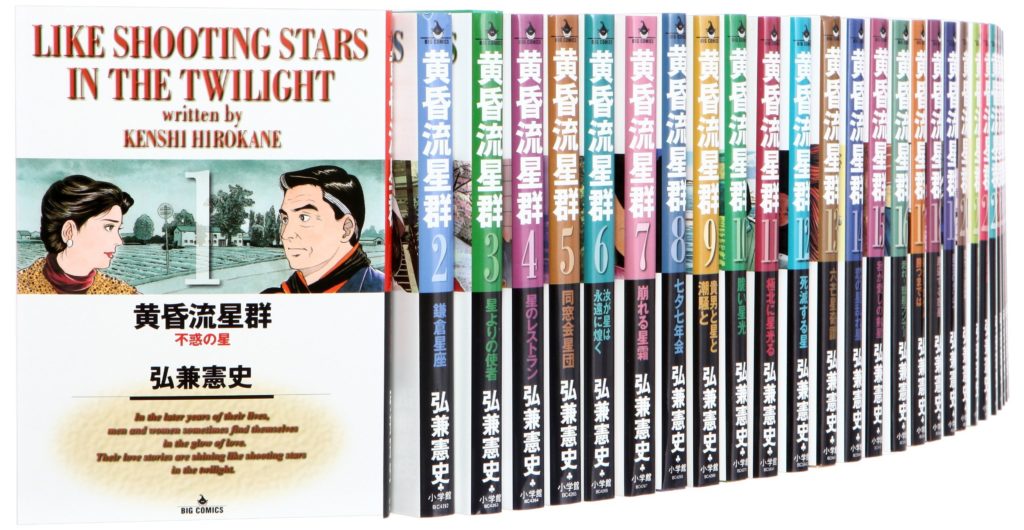
I didn’t know where else to stick this, but here’s an interview with Keshi Hirokane from a 2010 live event in Taiwan. I’m 1/3 through and it’s good, but I gotta write the show-notes, so I’ll stick this here for now and come back to it. Man, lotta good content on Anime News Network.
Hirokane is a machine, with ~200 volumes of manga to his credit having been released across his career, as well as a number of books on financial planning and retirement savings for middle-aged and elderly people. He is the winner of the 1985 Shogakukan Manga Award, the 1991 Kodansha Manga Award, the Grand Prize of the Japan Cartoonists Association in 2000, and the Japan Media Arts Festival Excellence Prize also in 2000. If you want an even more in-depth bio, check out the Baka Updates Manga page, he likes golf!
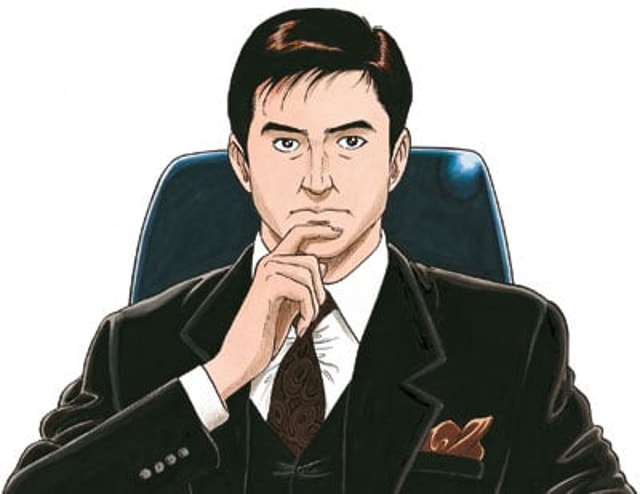
ABOUT DIVISION CHIEF KOSAKU SHIMA:
The Kosaku Shima stories by Kenshi Hirokane began in 1983, serializing in Kodansha’s Morning magazine, and there are now more than 100 volumes of Kosaku Shima in print across the various titles. The first series, Section Chief, ran for 17 volumes from 83-92, and then today’s read, Division Chief, ran for 13 volumes from 92-02. As mentioned, the series continues with him getting promoted up the ladder and in his current series, he’s an Outside Director, having finished up his stint as a Consultant in February, 2022.. They also went back and released several different prequel series’, as well as fantasy spin-offs, and we talk about some of that this episode. Actually, the Wiki for this is a trip, you should check it out.
My favourite part of that is that there are three video game adaptations of Kosaku Shima. Wild.
Kosaku Shima has escaped the printed page as well, appearing in a 1992 movie, two different TV dramas aring in the 1990s and 2000s, a two-episode tv-drama spin-off, and over a dozen collaborative or promotional campaigns. Here’s the promotional Kosaku Shima phone from Docomo, in a commercial from 1994.
Oh, and he also hosted a series in 2013 called “Kosaku Shima’s Asian Entrepeneurs”, a multi-season series of mini-docs about notable Asian businesspeople on the NHK. It was translated into English and ran on NHK World too! Check out this likely-illegal episode.
We talk at length this episode about the fictional character Kosaku Shima’s real-world impact. In addition to the manga, Shima’s creator Hirokane-sensei has also authored books about financial planning, and while he doesn’t do TV Shows (we talked a little about appearing on TV in our Sweetness and Lightning Episode), he does end up in the newspaper quite a bit, alongside his character. There’s a short overview piece in the Daily Yomiuri on the end of the Heisei era, and Kosaku Shima’s importance during that era.
But perhaps more interesting are these newspaper articles that feature Kosaku Shima the character in conversation with real people on pressing issues of the day. Here’s another one from the Yomiuri:
And here’s one from the pandemic, where Shima appears to be advocating for Telework during the pandemic:
North American business media has taken notice of Kosaku Shima as well, in a VERY interesting article in The Economist. You can read it with a free registration for their website here: https://www.economist.com/business/2008/08/07/a-question-of-character. It’s very clear that the author has maybe read the same volume we have and maybe one more, and in particular describing the sex-scenes as “gratutitous” struck me as very funny, since the crew found them pretty restrained, overall. Keep listening for that.
I don’t want to excerpt TOO much of this article, but these two quotes in particular stood out to help explain the position that Shima-san holds in society.
“Part of Mr Shima’s appeal, in addition to his timelessly youthful looks, is his respect for the Japanese virtues of hard work, self-sacrifice, loyalty and modesty. “My position is a result of the support of the people around me,” he said when he was named to the post. Despite his modesty, Mr Shima has been the subject of two television series and a film. He endorses snacks and beer, so that pictures of him, perpetually raising a glass, are plastered across Japan. Ladies cannot help but throw themselves before him. He is rather like a Japanese James Bond who swapped 007 for an MBA. And Mr Shima resembles Mr Bond in another respect: he is a fictional character.”
The Economist
And
“In the 1990s the president of Hatsushiba sought to defend a former friend’s company that was under threat of a hostile takeover, and dispatched Mr Shima to spare no expense and buy up its shares. Mr Shima was venerated for his success. Yet his actions represented a blatant conflict of interest and a misuse of corporate funds. In the West, the pair would have faced shareholder lawsuits and possibly criminal charges. When confronted with this, a wide-eyed Mr Hirokane can only stammer that Mr Shima’s actions were probably allowed in Japan at the time.”
The Economist
The article doesn’t seem to get on board with the manga, but the rallying point throughout is that the manga is deeply aspirational, for not only the workers and salarymen who read it, but for Japanese business and Japan as a whole. David talks about morality and ethics in this episode, and Kosaku Shima might be a good bellwether for that, in business. Anyway, this whole thing is the most mountainous molehill when it comes to North American manga and comics, but it was a fun episode to record.
04:00 Apologies to David, who does have a real job digging in the manga-mines each day to provide us with content. 🙂
04:30 Kishi Danchou Shima, aka Knight Commander Kosaku Shima, is kind of completely insane. Tying the popular character into the popular “Isekai” genre of manga where someone is ‘reborn in another world’, this has Shima-san wake up with a bump on the head where he’s the leader of a group of suspiciously-salaryman-looking knights in medieval world. The series is by Hirokane and Makoto Beppu, and ran for 3 volumes in Ichijinsha’s Comic Zero-Sum magazine, which I have never heard of before today.
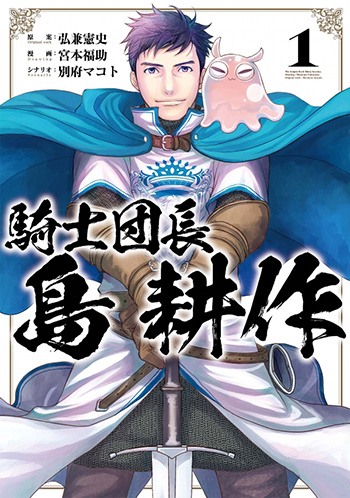
Like, yes, manga as an industry is eating its own tail a little bit, but as long as we keep getting funny random stuff like this, I’ll be happy.
06:30 It’s funny, things from the 90s and early 2000s do blur together in my head a little, and while I did grab my copy of Kosaku Shima off the shelf back when it came out, I don’t know if I would have quite understood what I was reading until Viz’s PULP magazine started serializing the manga Even A Monkey Can Draw Manga by Koki Aihara and Kentaro Takekuma in 2001. The gag/instructional/cynical manga starts off breaking down what manga is, before deep-diving on individual genres of manga and pulling apart what makes them ‘tick’. It’s like the secret key to understanding manga and it’s very, very good. I hate to say it, but if you google it, the pirated version is like the second or third link on google. Hopefully it gets reprinted one day? Anyway.
I bring it up because the chapter on Salaryman manga in Even a Monkey Can Draw Manga is only about Kosaku Shima, really, as the template for all that would follow, and has some amazing gags and razor-sharp insight. It mostly applies to the first series which we didn’t read, but man, I think the jokes work even without having read it. I’m just going to break my rule and include it here, because it’s SOOOO out of print.
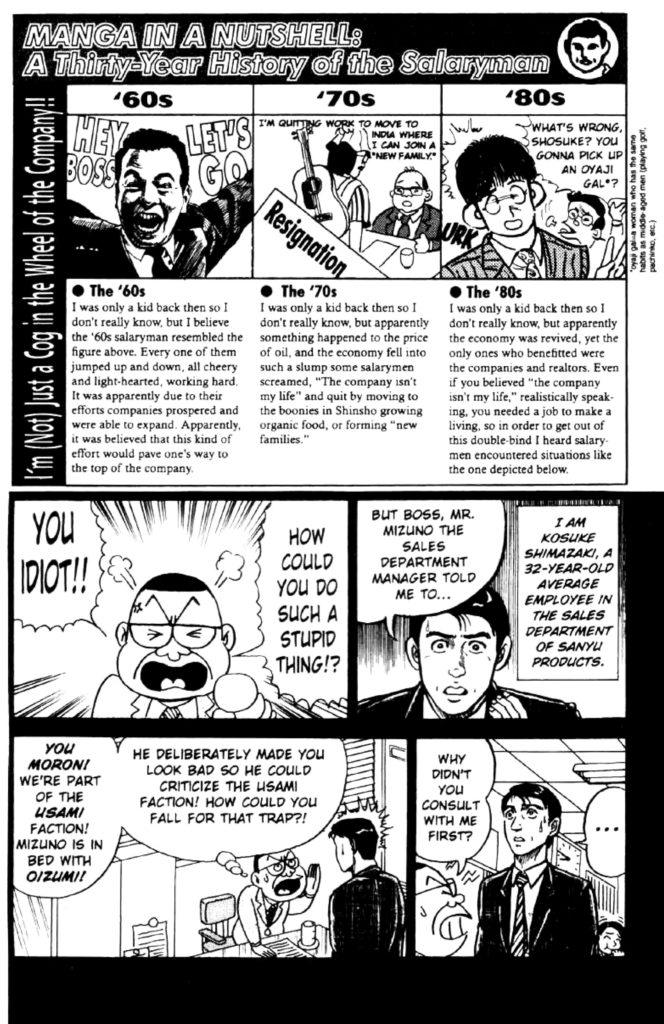
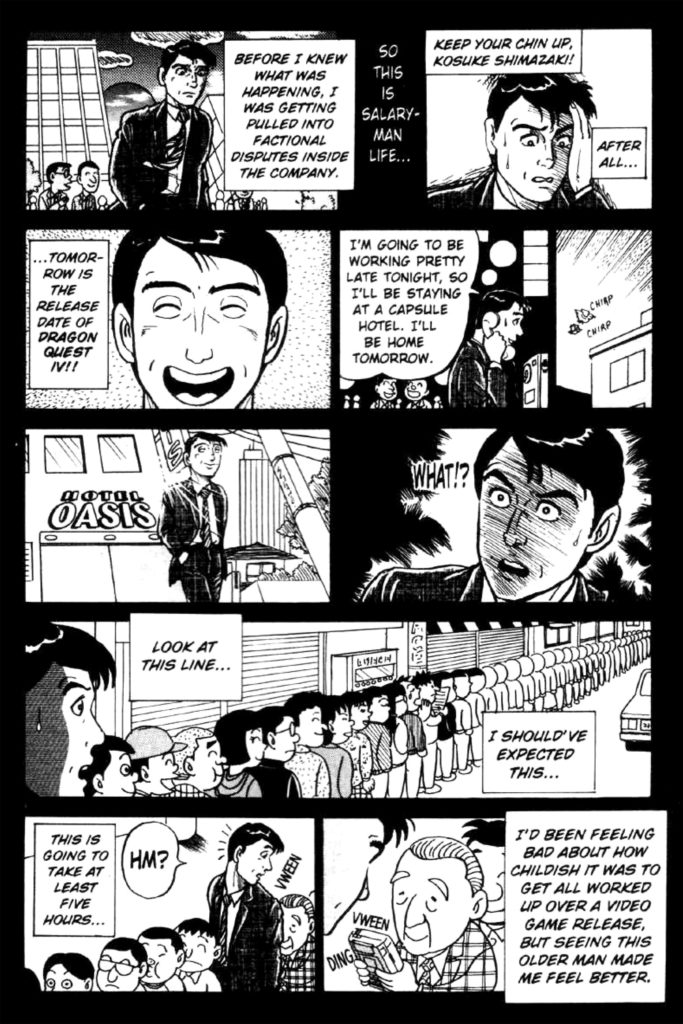
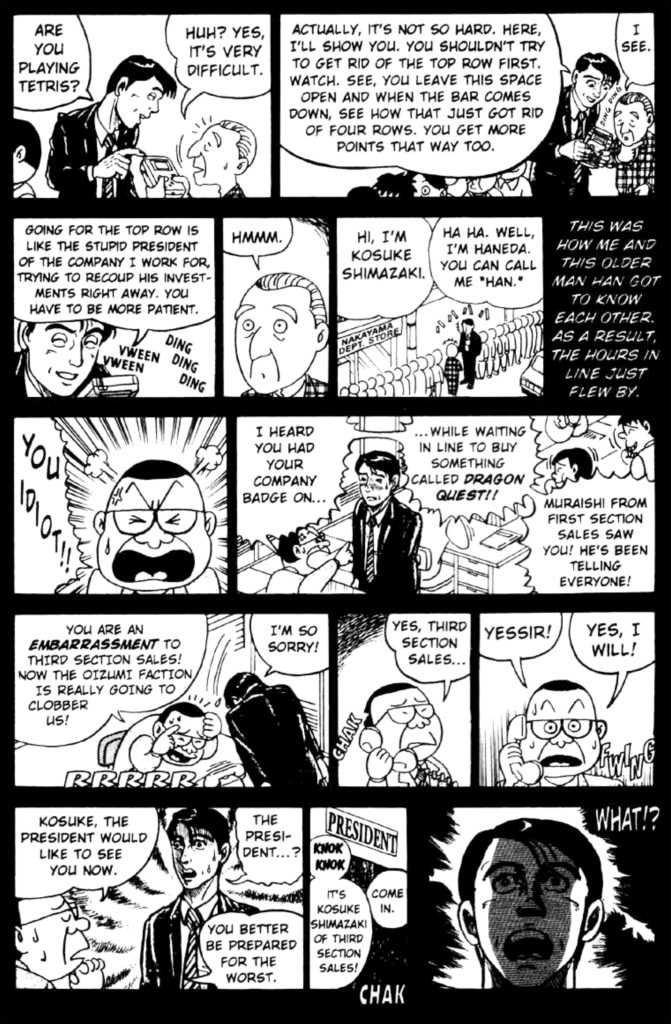
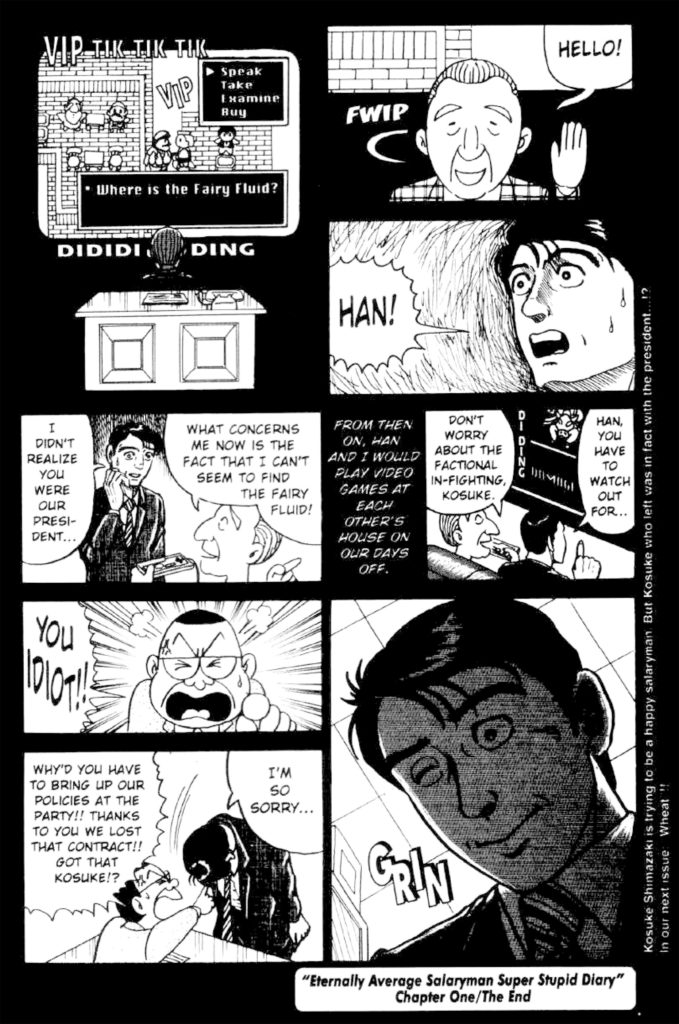
10:15 The last chapter in my volume, but mid-way through it in theirs (more on that later), is the shorty story “Unforgettable,” which has a daughter posthumously reunited with her father (in a business context, of course). But since it’s a nice song, let’s include the video for Unforgettable by Nat King Cole and Natalie Cole. I can’t find the original video in anything watchable, so here’s this symphonic live recording that’s pretty nice.
12:00 When something big happens with Kosaku Shima, people take notice. Here’s a quote from Japanese Wikipedia that will enlighten you.
社長就任の新聞報道
2008年4月2日、読売新聞をはじめ各全国の新聞朝刊の社会面に島耕作が作中で近く社長に就任することが、経済面でおなじみの新社長就任記事を模して「新社長に島氏」というタイトルで採り上げられた。
Newspaper coverage of the appointment of president
On April 2, 2008, in the morning editions of newspapers nationwide, including the Yomiuri Shimbun , it was announced that Kosaku Shima would soon be appointed as president, imitating the well-known article about the new president’s inauguration on the economic front. It was picked up under the title of Mr. Nishima.
Wikipedia
15:15 Sometimes Shima gets bad jobs to do too, like having to go and lay off a perfectly nice guys who DARED to criticise the boss’s opinions in a meeting. Shima comes through these situations mostly unscathed, but bad stuff is definitely going down.
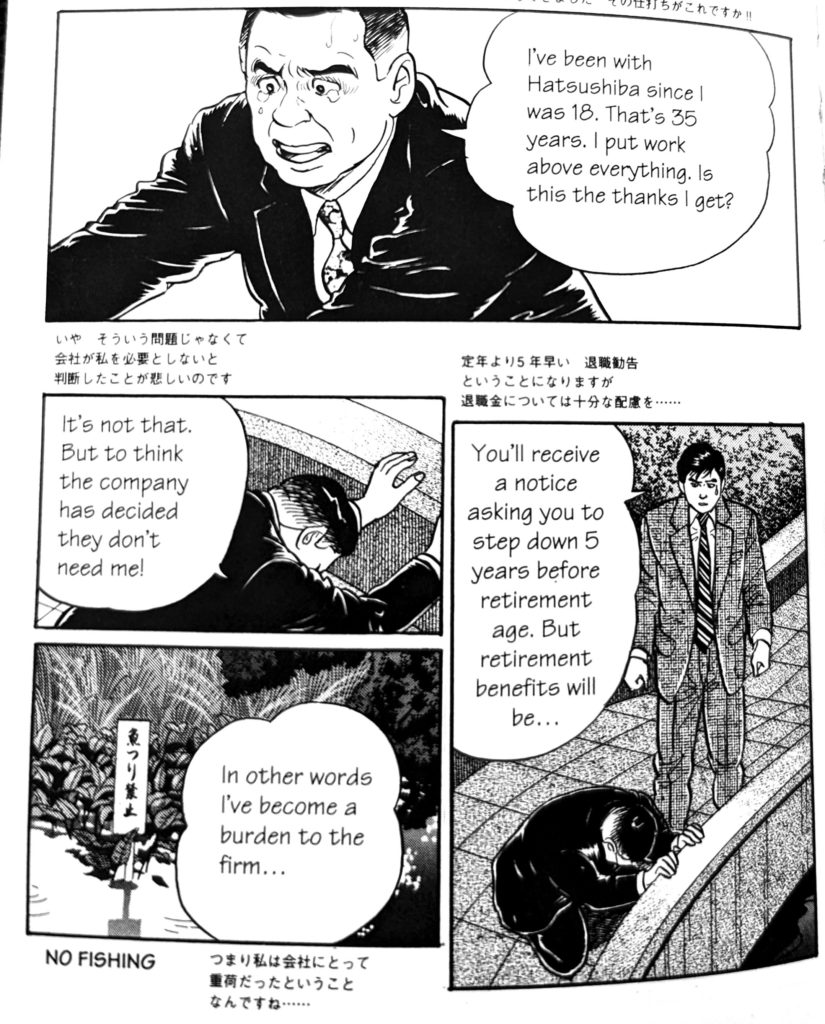
16:58: He liked it!
18:30: This really is one of the smoothest sequences in the entire book, with the birthday candles and Tokyo Tower. I kinda hate to spoil it, but I wanna show you something really good so you get why this is a great manga.
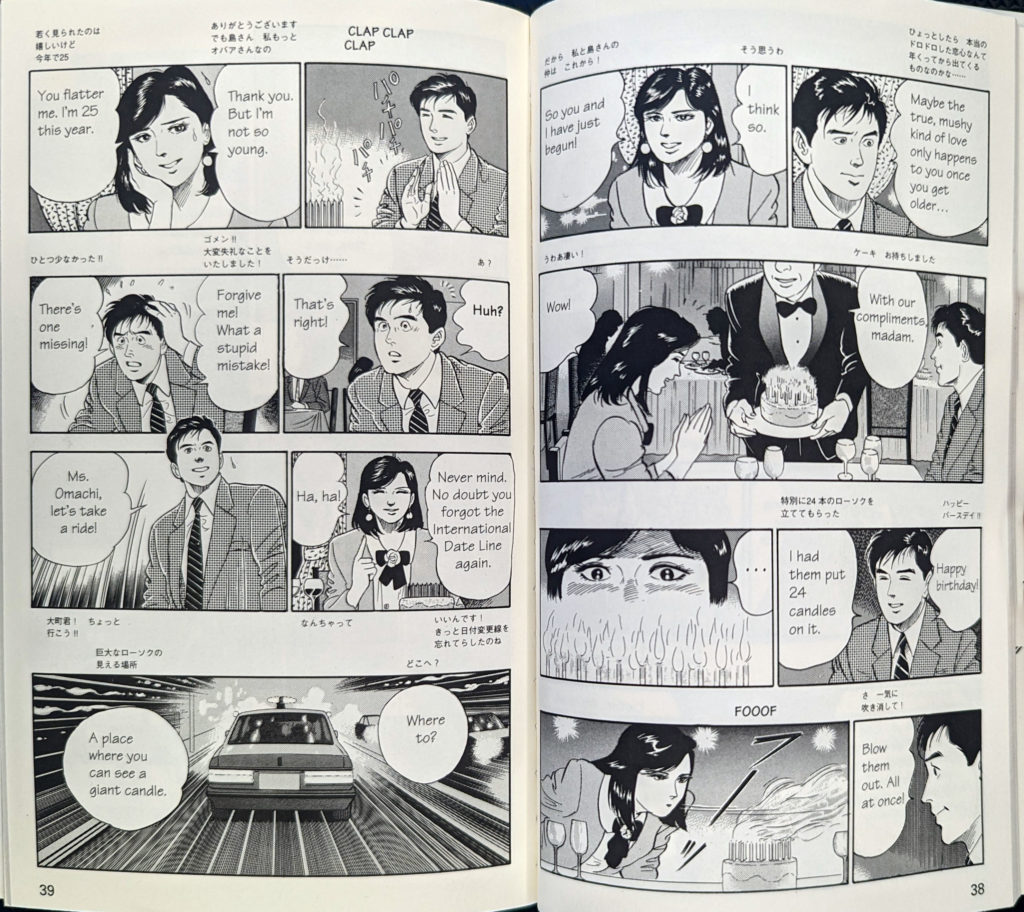
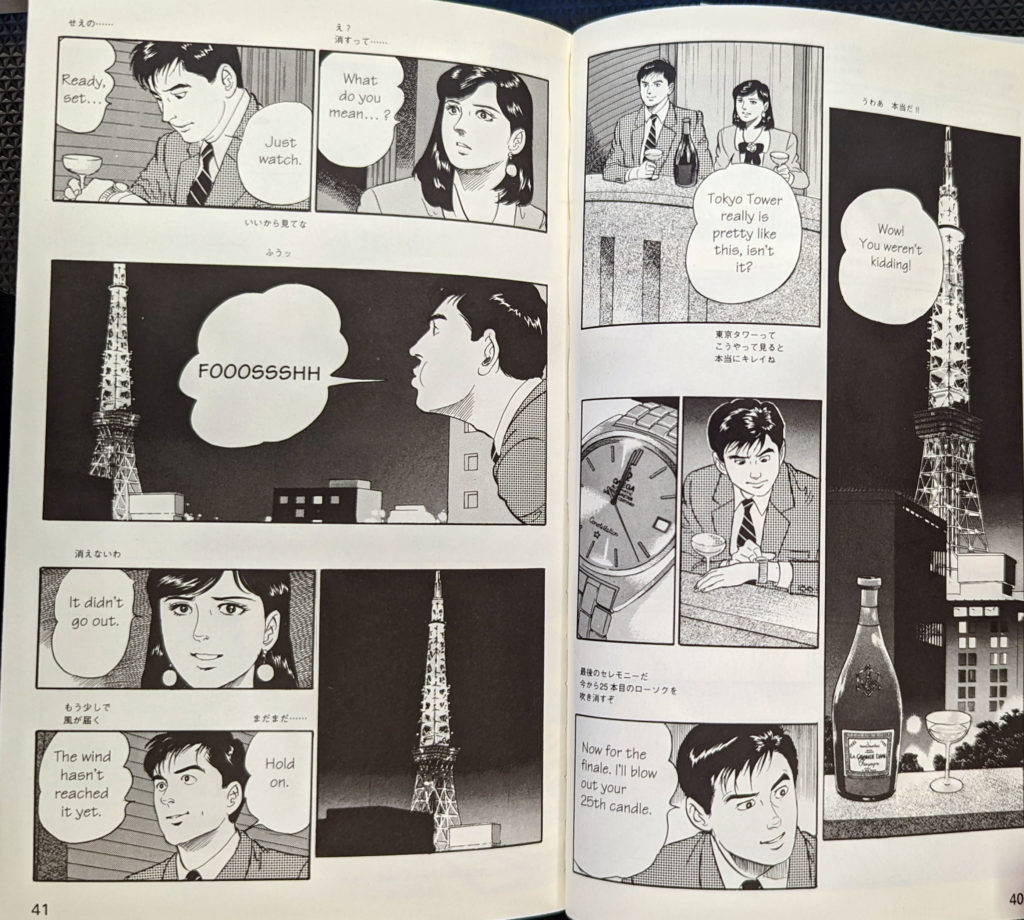
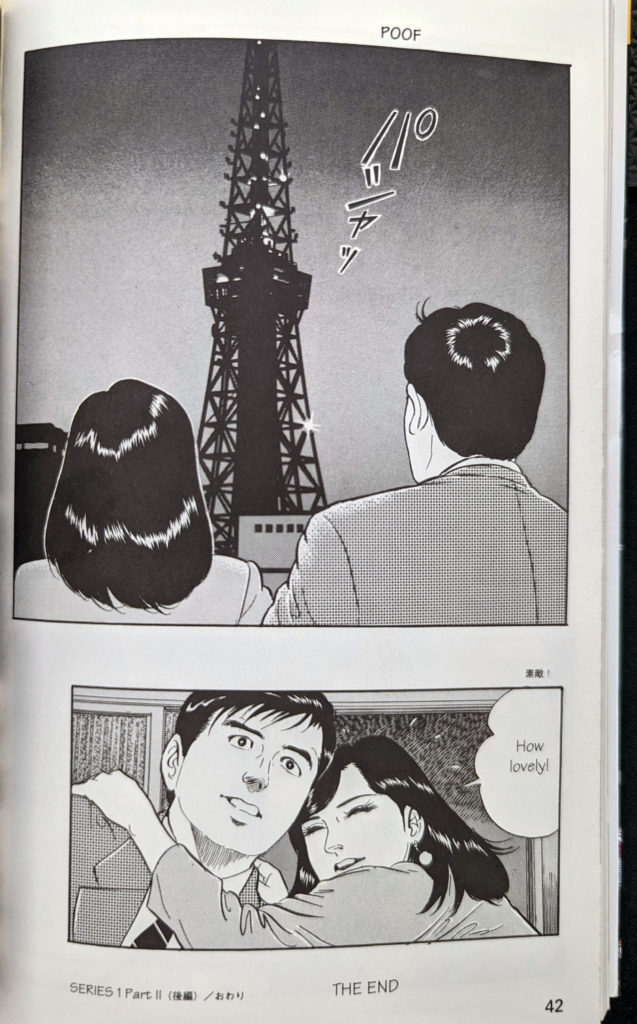
20:48 Chip’s right, the cartooning on the bad-guy in the takeover episode is pretty great, and totally well-cartooned.
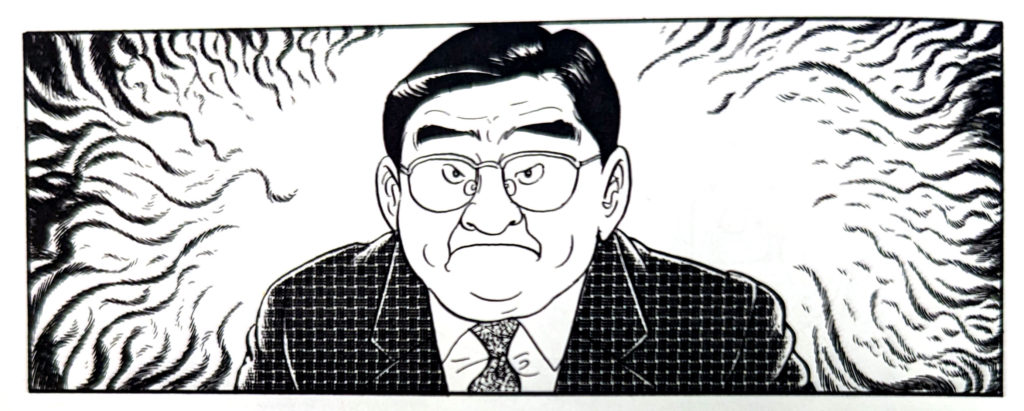
21:10 Chip mentioned that “He drew every window in the building AND all the buildings in the reflections,” and while those were drawn, I think we can successfully credit that to Hirokane-sensei’s whole team at this point, given how many different series’ he’s working on.
21:41 Yeah, not just the cartooning, but the angles chosen to make the talking-heads more interesting on the page. Specifically this ending sequence, when he’s threatening the guy he does so from a cat-walk to give it a lot of visual interest.
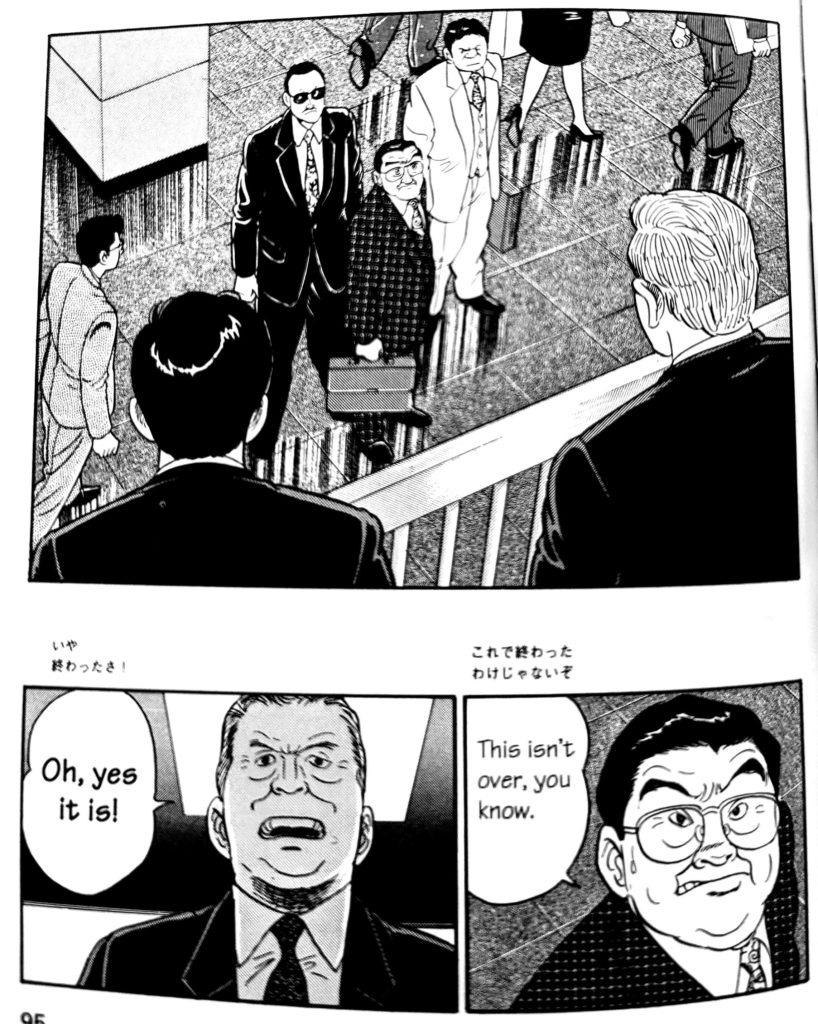
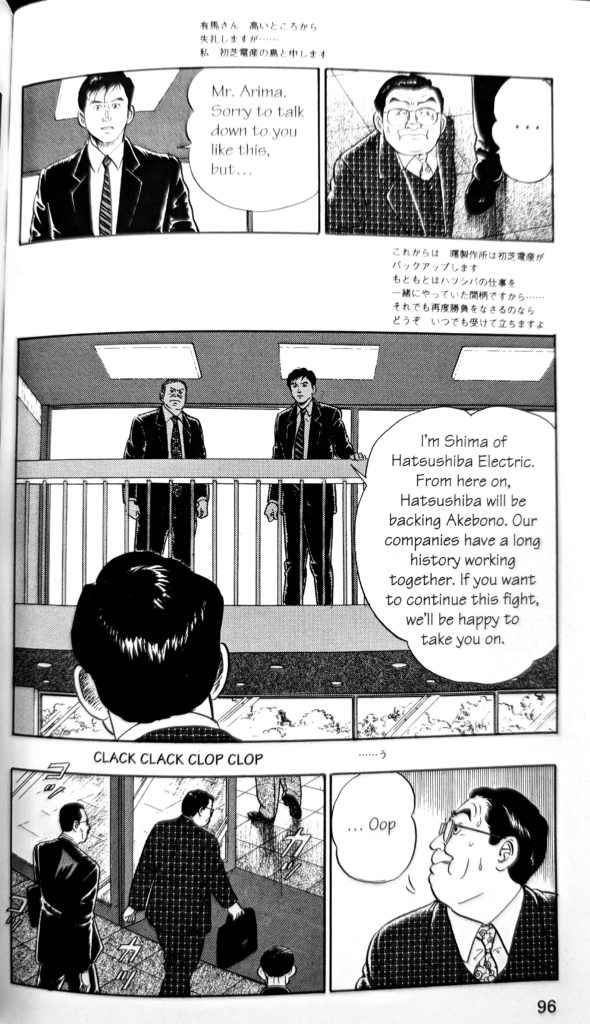
23:00 Just to confirm: I was working at a comic shop in 2000, and did, in fact, order the first volume of Division Chief Kosaku Shima in for the shelf. I actually wanted to double-check my memory on this one and went to Diamond and typed it in, and they still had their original listing! The June 2000 previews, JUN002148, and it shipped in September, and it was imported through the Tohan Corporation, who did a lot of importing at the time. The price was only US$16.95, which probably would’ve been about $24 Canadian with the exchange. 🙂
24:00 I go through and talk a lot about Bilingual Manga here, and these are still available at most Kinokuniya locations. Here’s a shot of that shelf at the big Kinokuniya in Tokyo, and you can see not just the Kodansha bilingual titles, but several other titles as well.
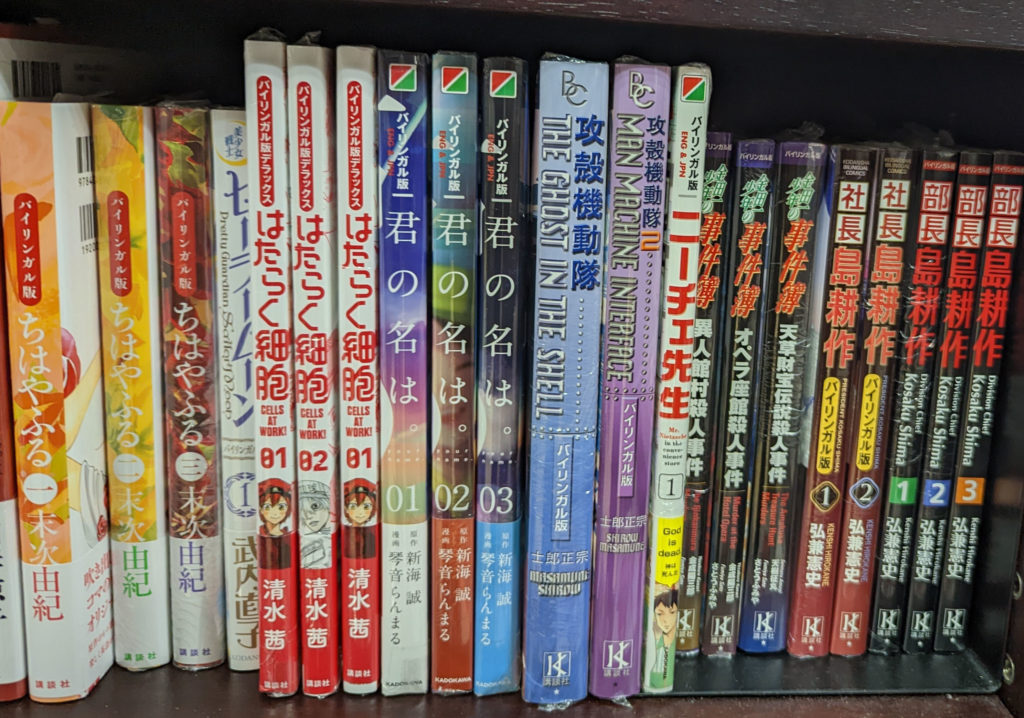
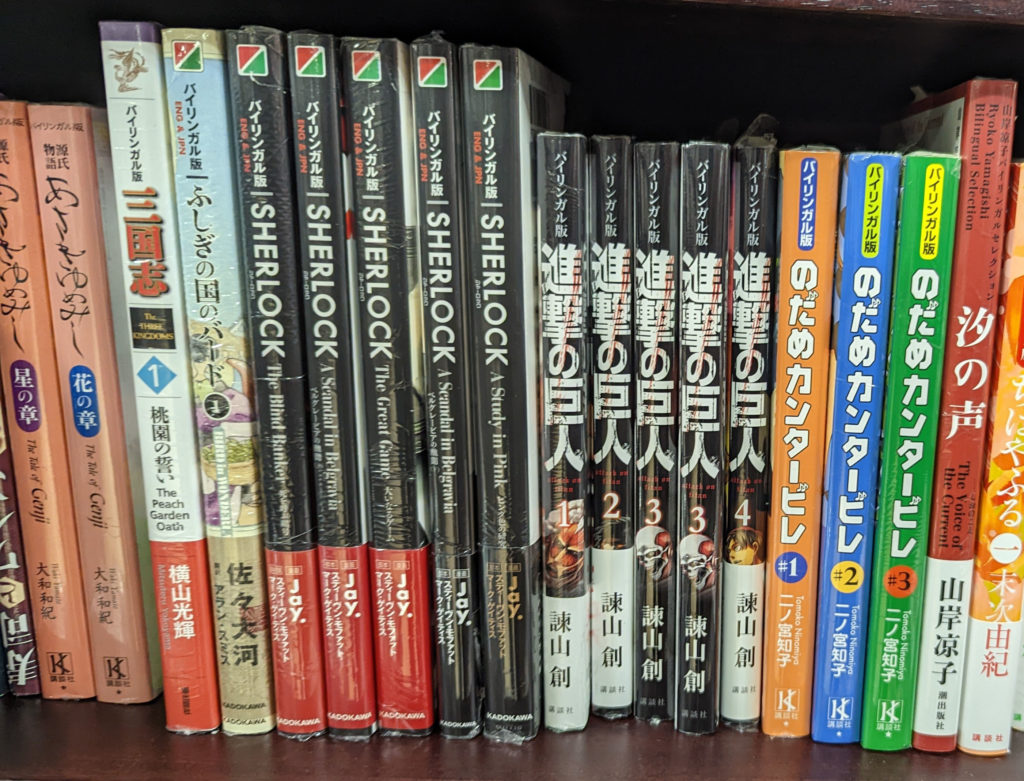
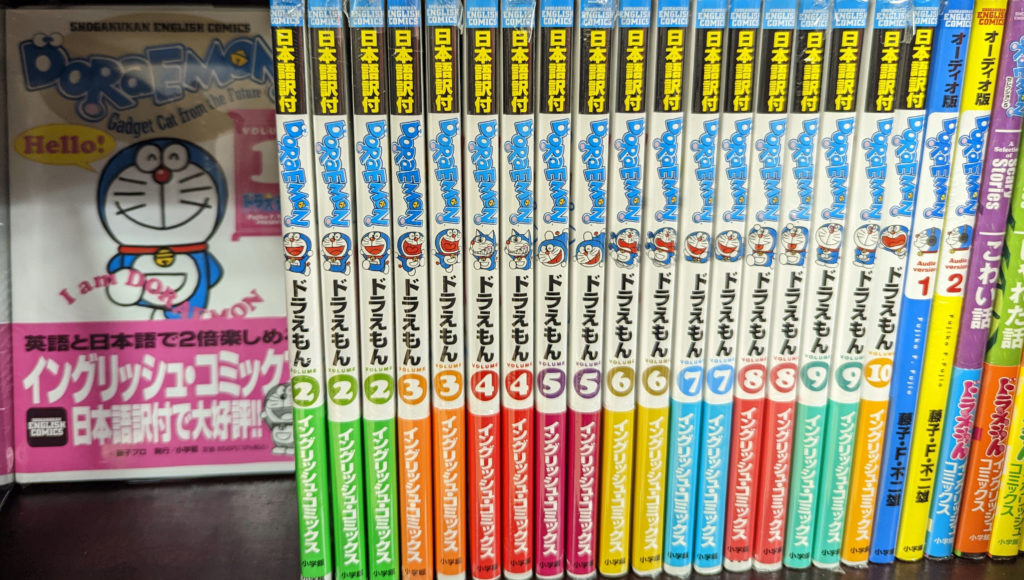
I know it seems vaguely crazy to be hunting down rare English-language manga given the absolute DELUGE of new manga released in English monthly, let alone the digital releases, but alllll of that said, there’s some truly weird rarities in these bilingual editions, unlike anything commercial we might get. If you’re interested in Japanese culture in addition to the manga we’re reading here, there’s a lot worth checking out.
24:40 Kate Beaton’s powerful 80s lady executive comics are just so, so good. Don’t click that link until after you’re done here, or you’ll get lost down the rabbit-hole of Kate’s work.
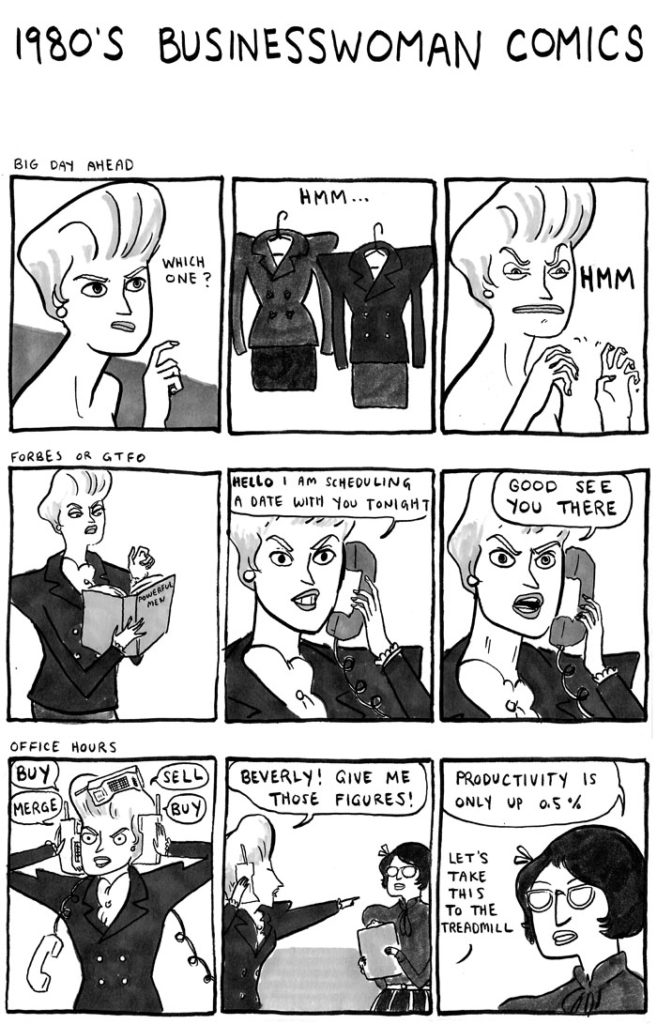
25:08 It’s true, they added extra vertical height to the manga to make space for the Japanese text translations! Here’s a comparison of some of the pages so you can see what they did, and how they treated some of the art elements that crossed panel borders.
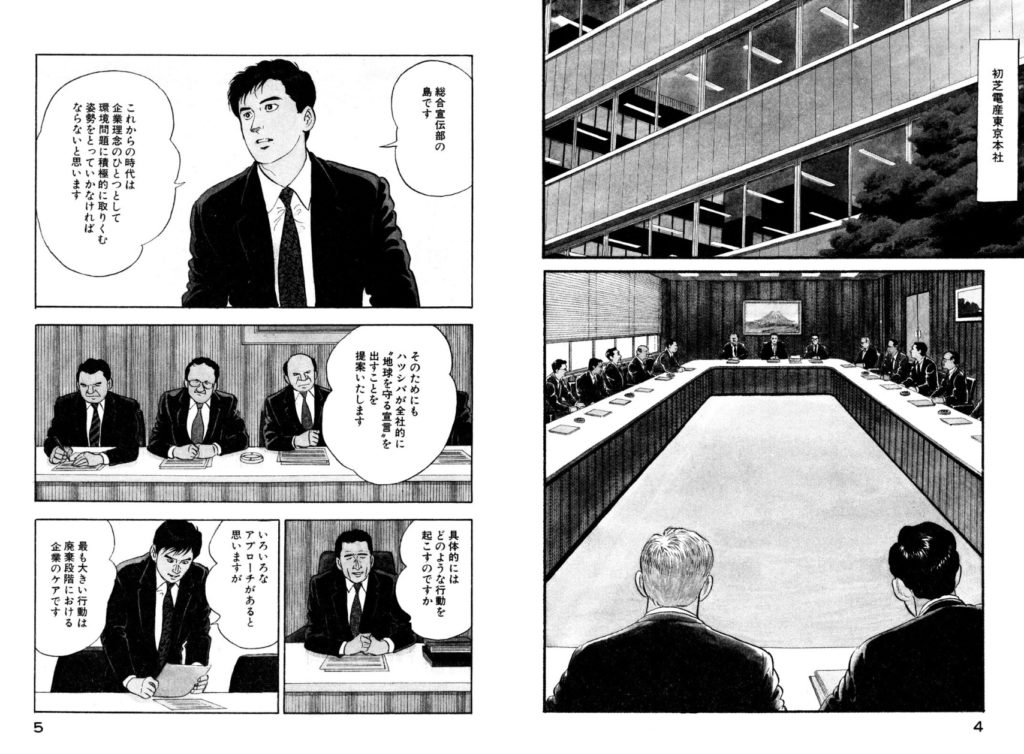
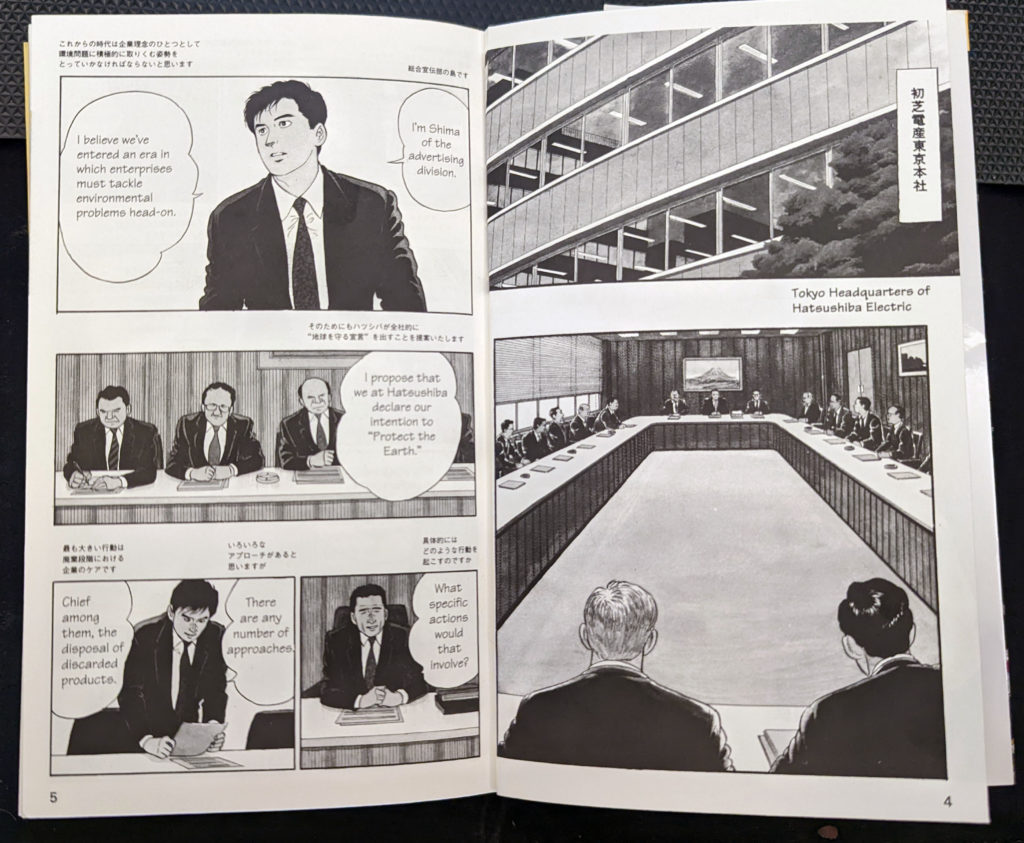
You can see that the pages are more-or-less exactly the same, right down to the fairly large word balloons. Even the instance where there would have been real problems, the caption box of the upper-right-corner, they just left it in Japanese and included the English underneath rather than redrawing the box. The only difference is really that there’s more whitepsace between panel ‘tiers’.
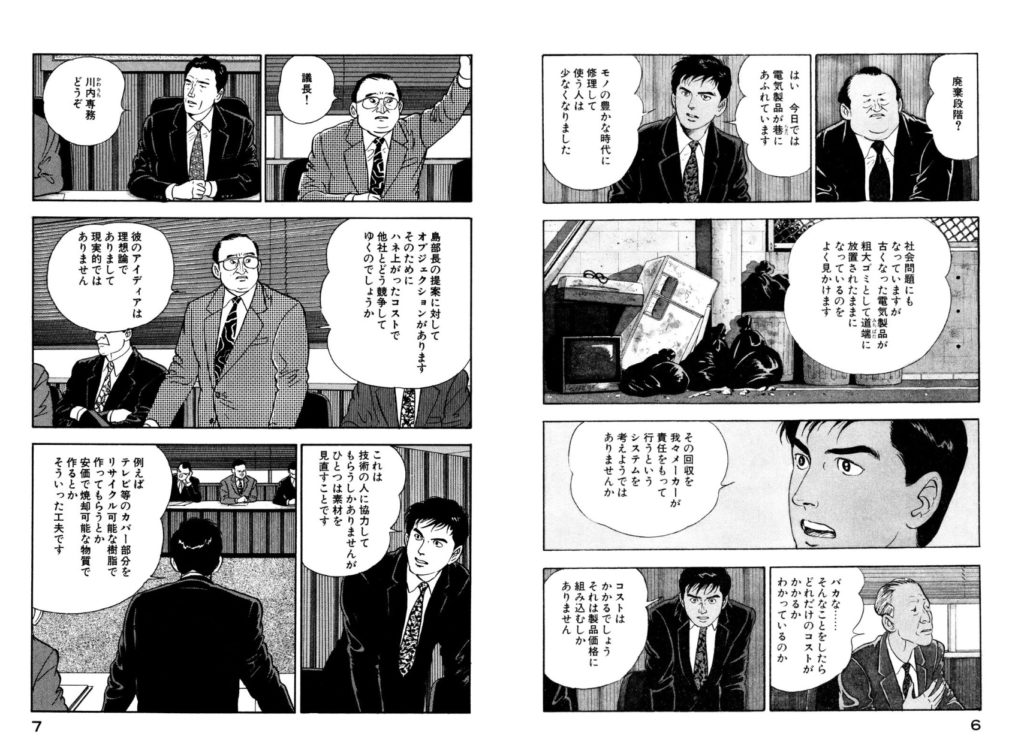
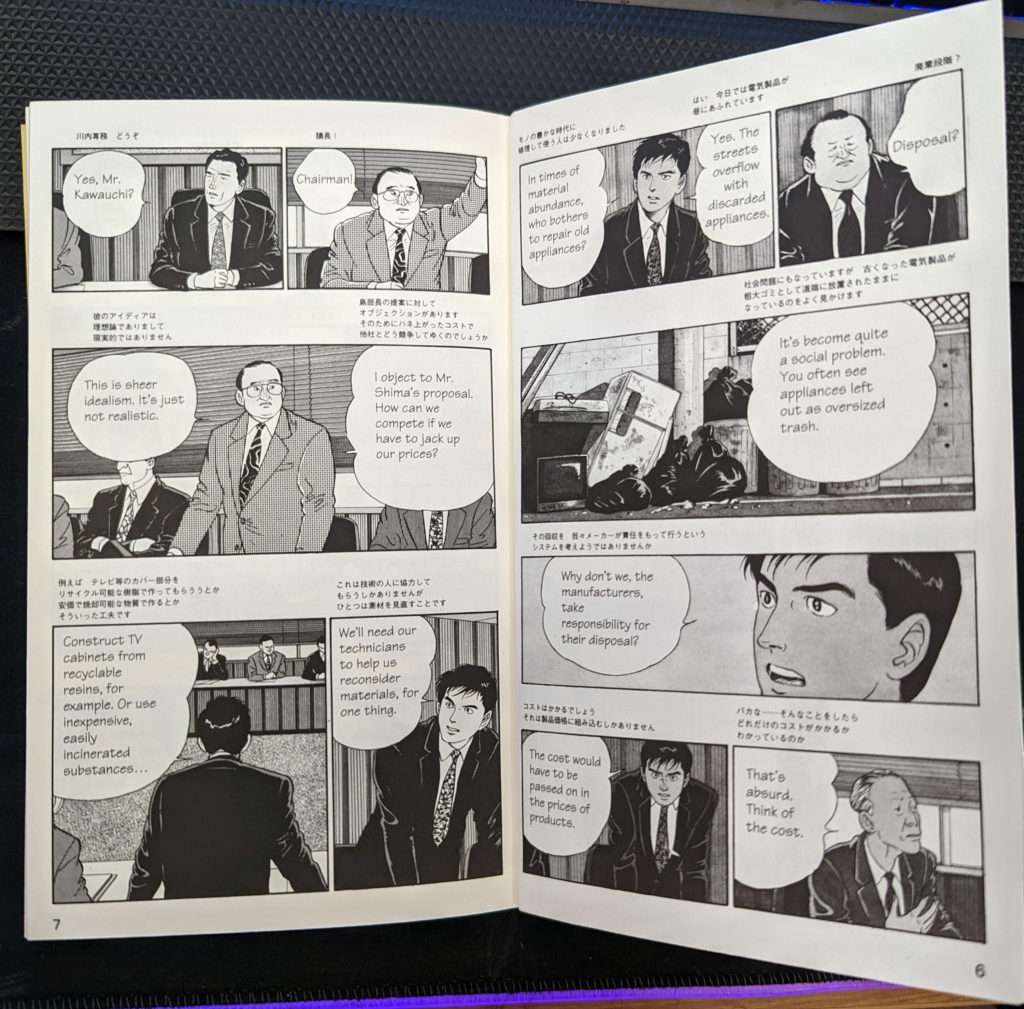
Again, pretty straightforward, though more tiers means the work is pushed closer to the top and bottom margins.
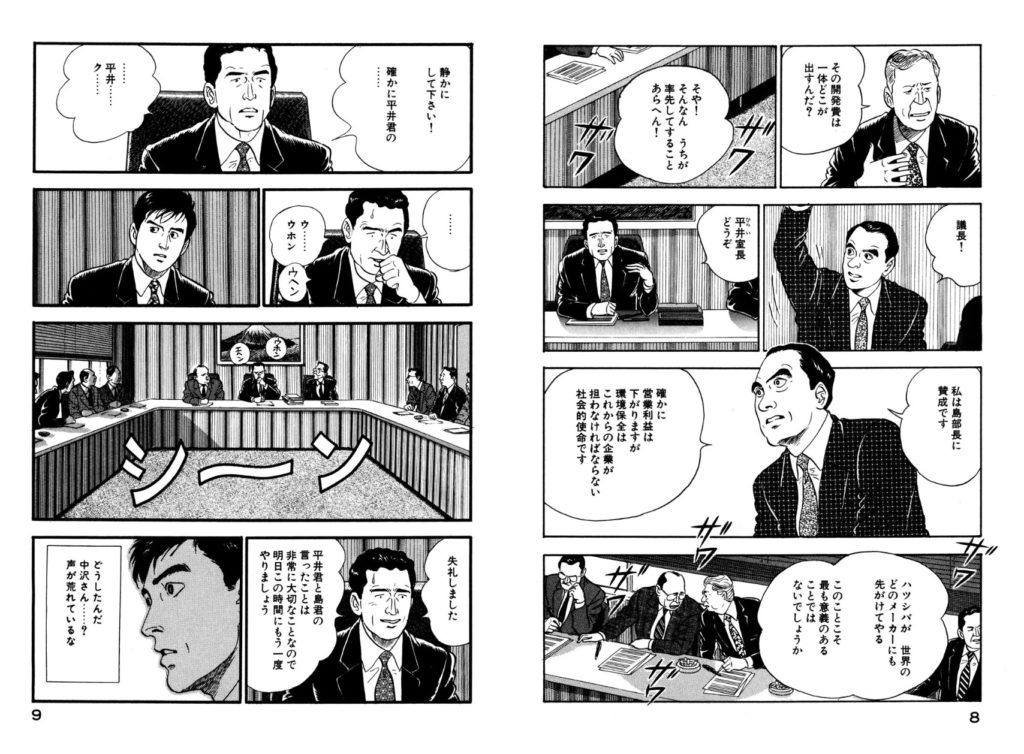
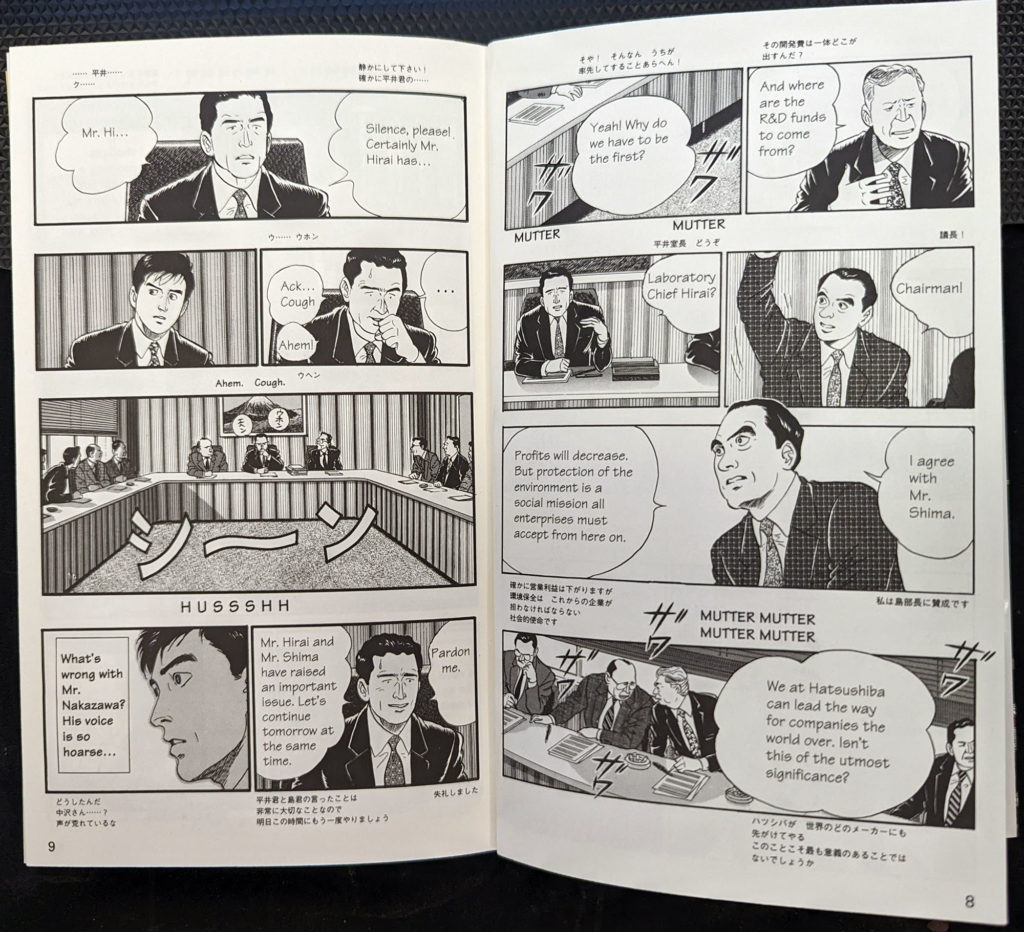
Finally for this spread they’ve left the margins intact on the right page where the head crosses between panels 3 and 5, and added a bunch of extra space between panels 5 and 6 to accommodate the extra text AND they work around the sound effects. Some thought and art really went into this…! And yeah, those word balloons ARE pretty generous for a series like this. Though you can see how much… better… the Japanese lettering is clearly now.
32:50 Cell phone in the Paris Chapter. Man, I’m still not sure if that’s a cell phone or just a cordless. Like it looks like it flips, so it’s probably a cell. Oh, and the old-school phone is beside the bed. Alright, totally a cell phone, that somehow doesn’t impact the story at all. 😉
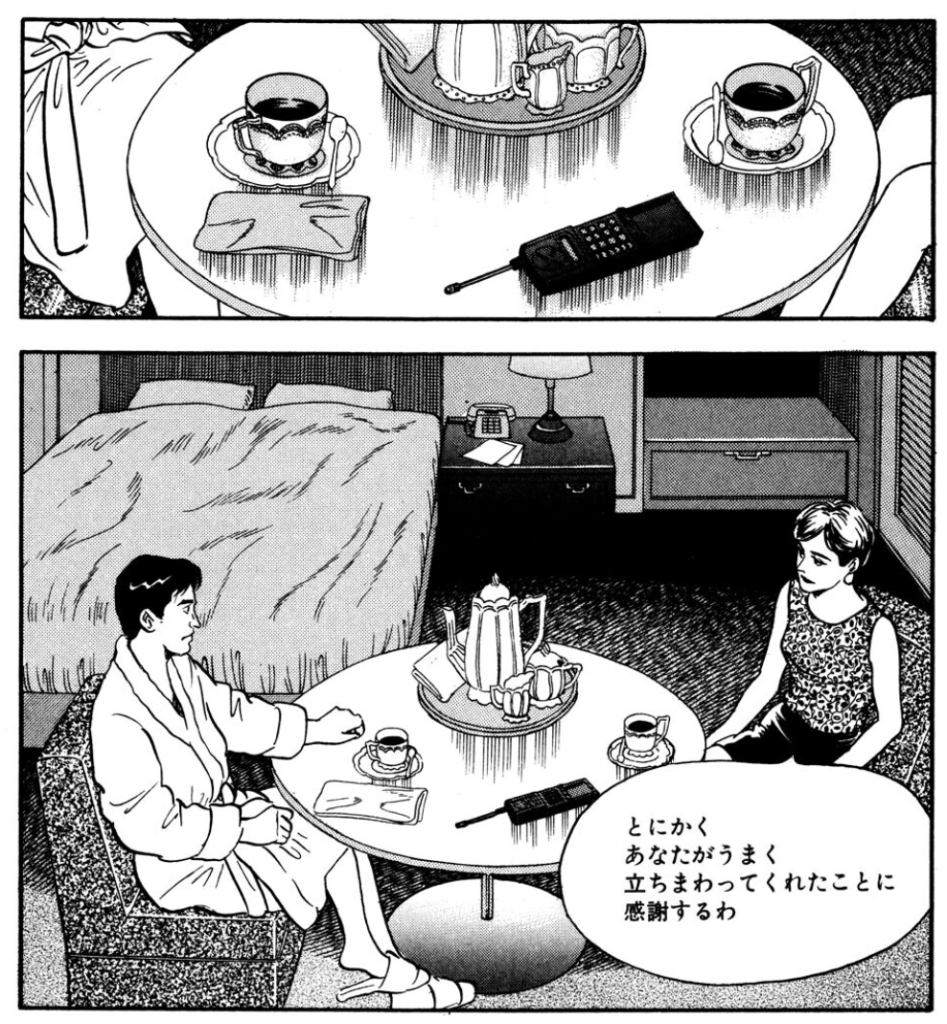
33:40 Maybe we should give a shit about the environment? A man of principles. Like, it’s the 90s, so sure, Earth Day was a big thing there for a while, and I do appreciate this, it’s not a bad program he proposes either, though it would never fly since planned obsolescence is the name of the game for electronics manufacturing…
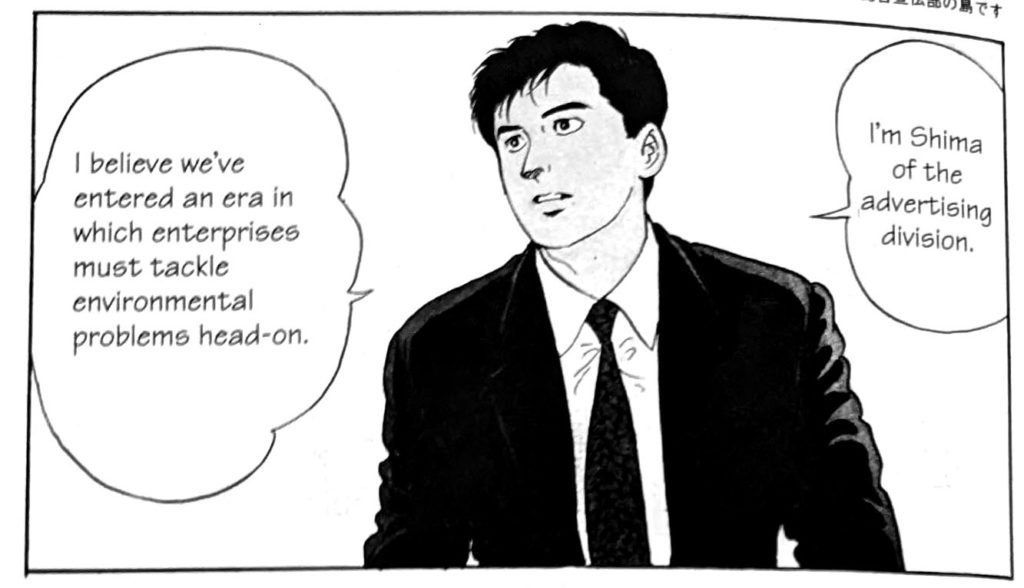
And yet the response comes from Shima’s rival, who just comes off like a cartoon villain.
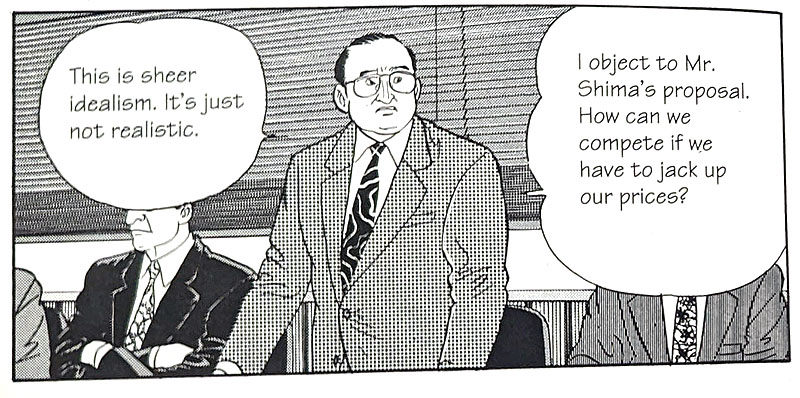
35:05 David finds the sexytimes to be a bit lacking in passion, at least in the lead-up, but it does appear very passionate on the page, when it’s happening!
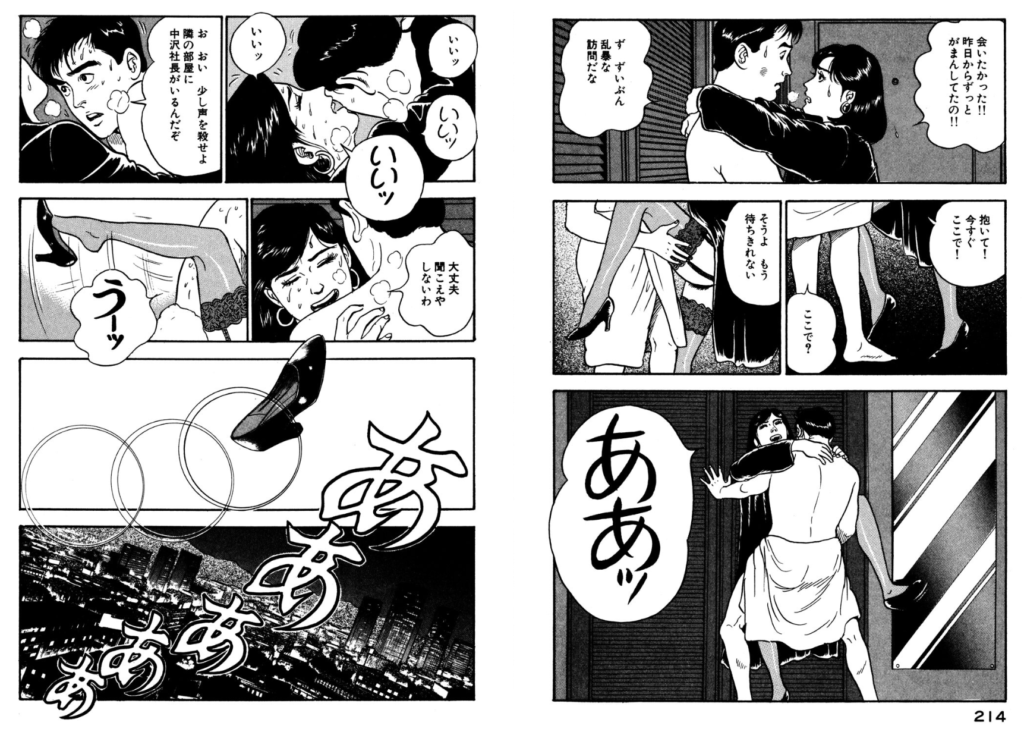
36:10:
“This comic is businesssexual.”
Chris
36:30 Yeah dude just out-and-out screams at his daughter in a rough moment…
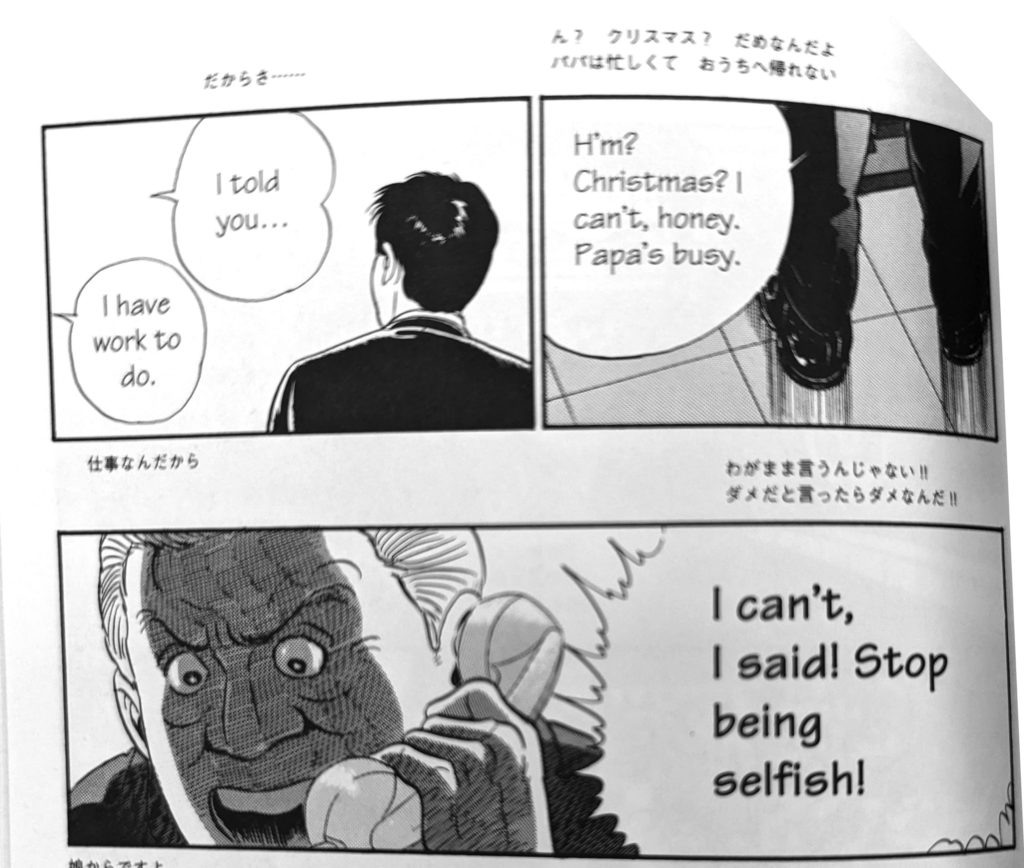
…and then gets his comeuppance on Christmas Eve. It’s… like damn.
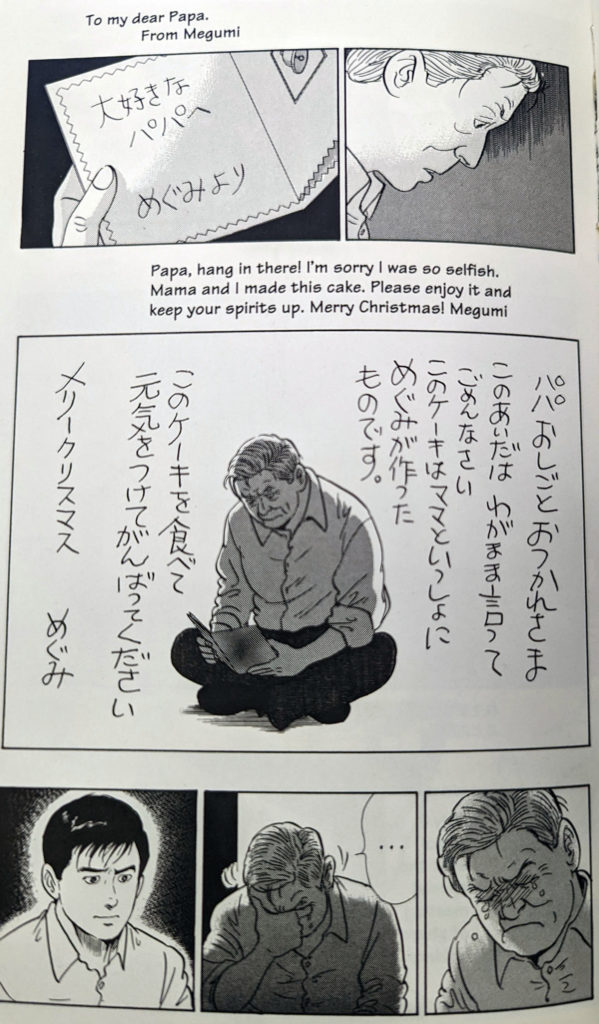
This manga is really trying to have its cake and eat it too. Its Christmas Cake.
37:00 Yeah that whole takeover segment ends in a deep, almost sinister way. We’ll settle up later. I can’t imagine what that looks like. But ending on the shot of Mount Fuji is very, very deliberate.
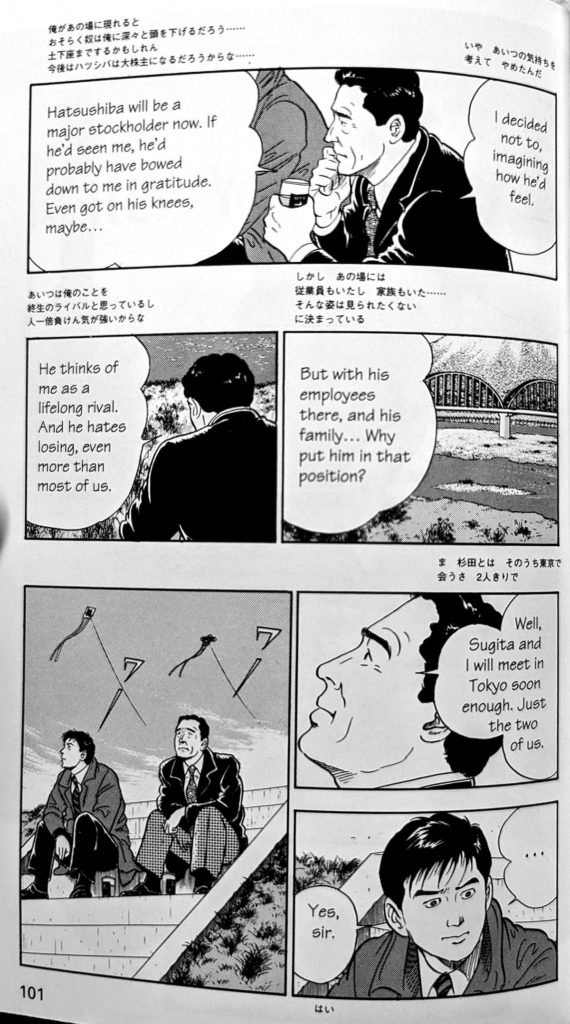
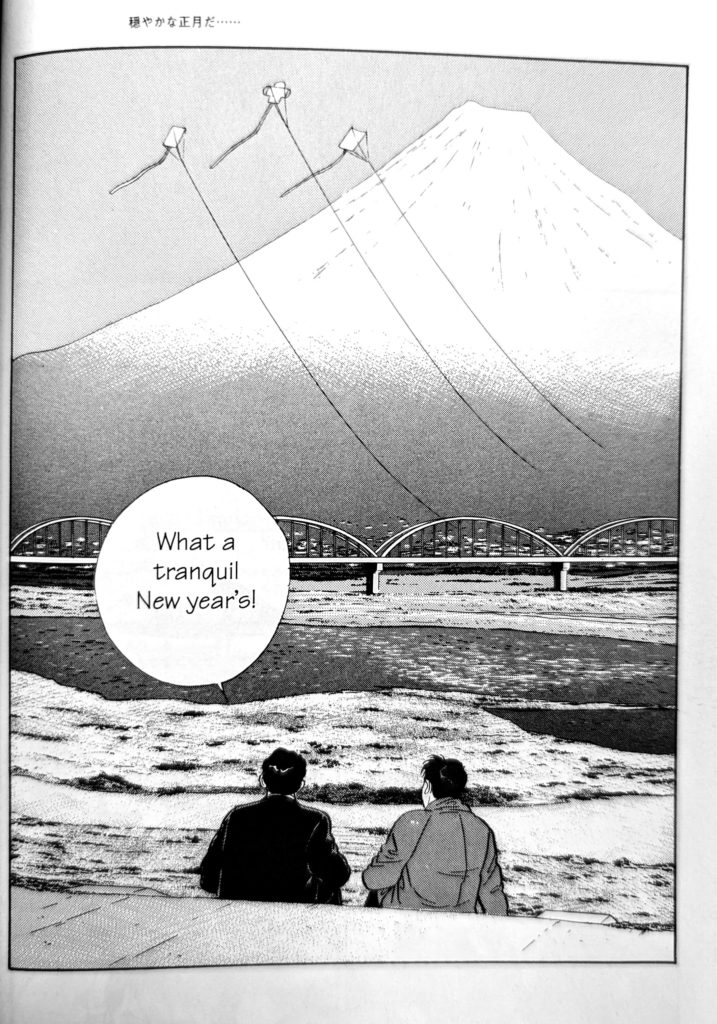
38:20 David brings up the red-headed 90s “lost son” (who was actually a clone) of Lex Luthor, and the ways in which he ran his business. Basically, Lex Luthor (the original) got Kryptonite poisoning and died, but not before transfering his mind to a healthy new clone body, and passes himself off as his own illegitimate son, Lex Luthor II. He’s a jacked ginger daddy-bear of a man (with an Australian accent), and basically there’s a strange focus to the ‘business’ of running lexcorp during this period, around 1993 or so (right when the stories we’re reading would’ve taken place!). Of course, Luthor did eventually lose the clone body and sexy hair, and wind up as the President of the United States. So, uh. Yeah. Let’s just focus on these few panels.
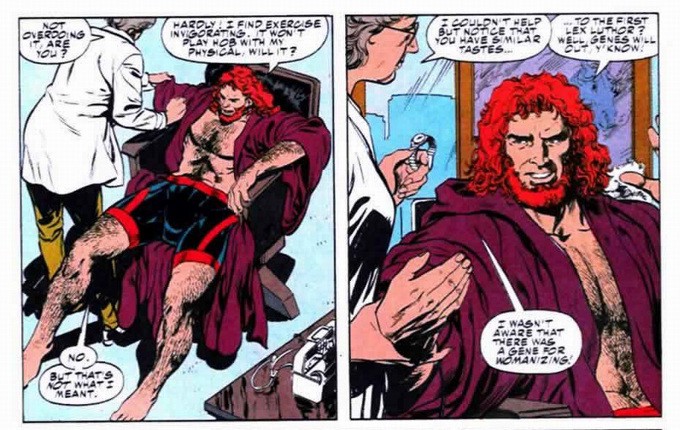
38:58 So yeah, this is a huge thing here. The Kosaku Shima manga started at the beginning of what would become the Japanese Economic Bubble. It was driven by many asset inflation, especially stocks and real estate, and led to a period of unprecedented prosperity from 1986 to about 1991 or 1992. This series starts when the bubble has burst, and they’re already talking about Japan entering a ‘recession’ by the end of this volume, but really it was a full on depression that would last more than a decade, and that the country was still climbing out of when Corona hit. Basically, we’re reading business history in ‘real time’ with this manga, and it’s pretty darned wild that this comic existed when it did.
40:26 David mentions the Yakuza video games here, which look back at these events with the distance of time and with greater perspective, and across both the entire series and some of the individual games which offer significant time-skips, offer a really unique look at a particularly flush and flashy area of Tokyo, Shinjuku’s Kabuki-cho neighborhood. It’s a very real-world location that has changed dramatically since the 1980s, more than once too. Check out this video that compares the modern-era setting of the game and the real-life inspiration of Kabuki-cho, to get a sense of the attention to detail. Trust us when we say that extends backwards, too, and the games set in the 90s are amazing.
41:24 Lighting and exhaling on a cigarette in the same panel is a pretty interesting comics trick.

44:00 As mentioned op top, there are small changes to accommodate the work, but for the most part they’re pretty similar, word balloons and all!
45:40 Chip had an issue with the lettering, and I think it’s fair to say it’s a bit sloppy. Text is pretty regularly butting right up against the panel borders and balloons. But it’s not outside of the range of what I’ve seen in domestically produced manga either, so YMMV.
48:40 It’s true! We found out Mid-Podcast that we’ve got different versions! Lol. Red & Yellow band across the top? Missing 3-4 chapters of story! Luckily you can’t buy that version anymore, only the new version, but beware of used copies.
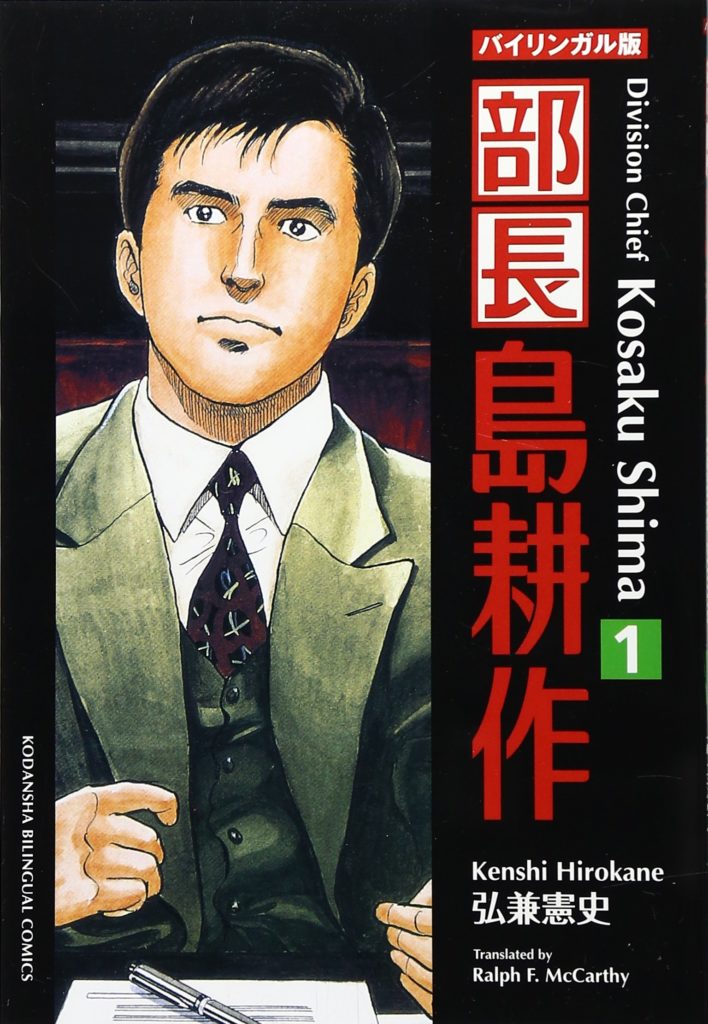
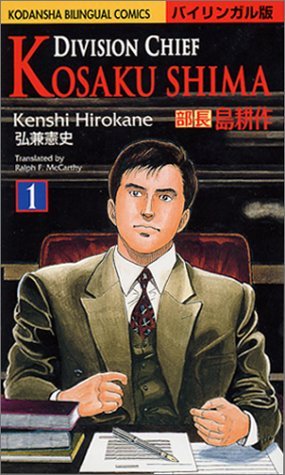
Also worth noting! Neither of these editions of Kosaku Shima is entirely “complete”, compared to the Japanese edition! Having bought the Japanese ebook for this episode to do comparisons, I noticed that a 2-page Omake, or author’s notes, comic that appears in the Japanese edition isn’t present in either of the bilingual editions. It’s about author Kenshi Hirokane’s trip to Paris to research the book, and it’s totally cute. He even is like, nice and positive about gay people in it, which was honestly shocking to read. Can’t reproduce it here (I’m already butting right up against the line of fair use with this episode) but I can show you a little taste.

50:02 This beautiful Sweater-wearing Kosaku Shima from the back of the first volume is pretty great.
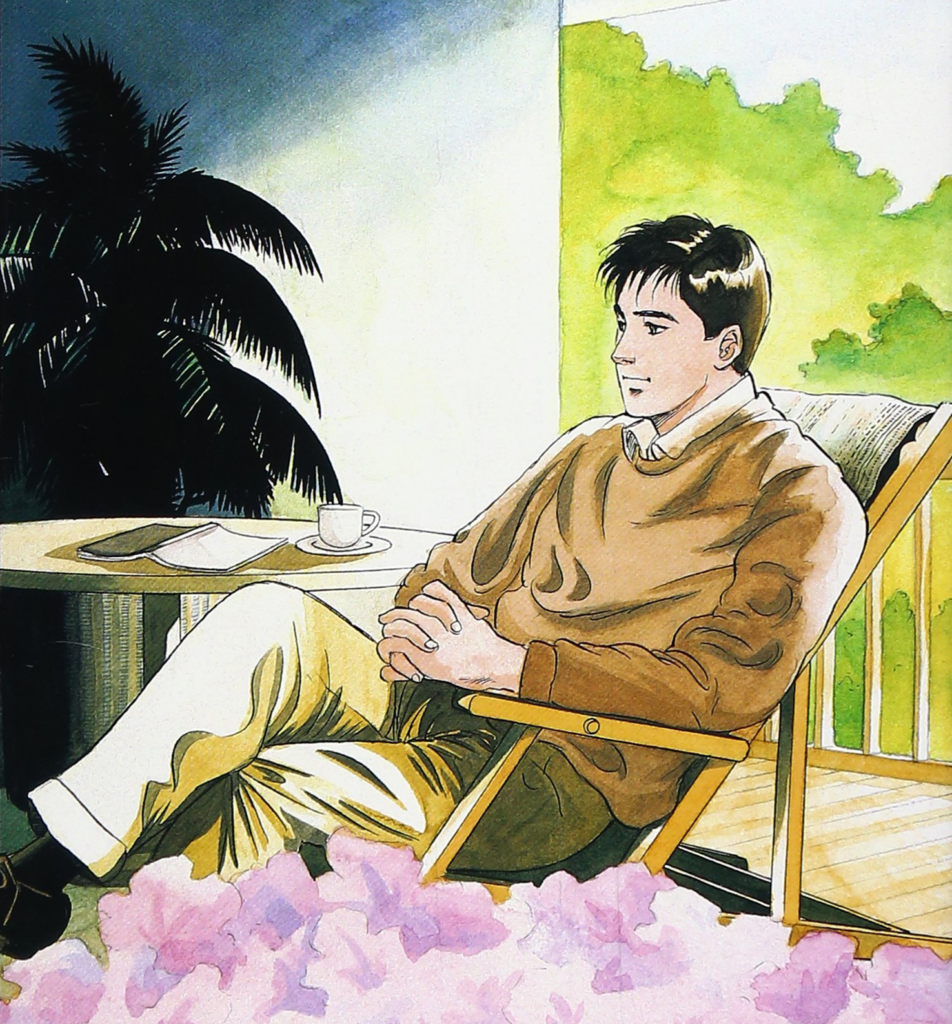
And then his move up the corporate ladder in the next series corresponds to not only a new wardrobe, but an interesting new rendering style. The 90s, man.
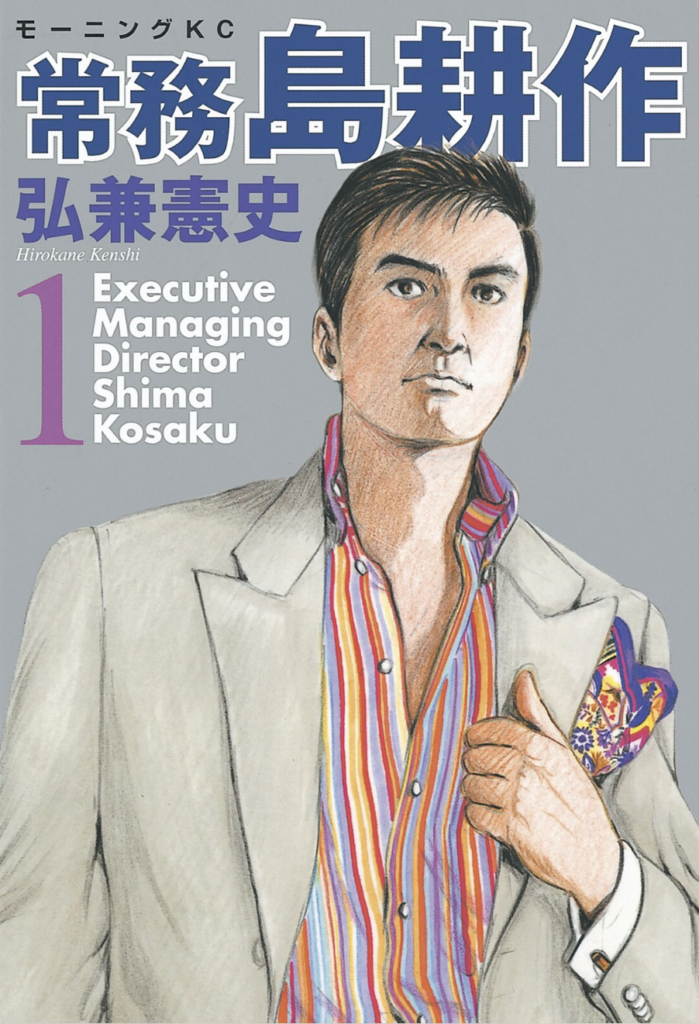
51:38 Deb mentions the manga Shooting Stars in Twlilight, which we covered in the introduction as a series of short stories about middle-aged and elderly people, with a focus on love and romance. This 60+ volume, ONGOING series of short stories is fascinating and even less likely to be picked up for publication in English than Kosaku Shima. Despite the best efforts of The Manga Curmudgeon in their blog post from 2009, where I ganked this image from.
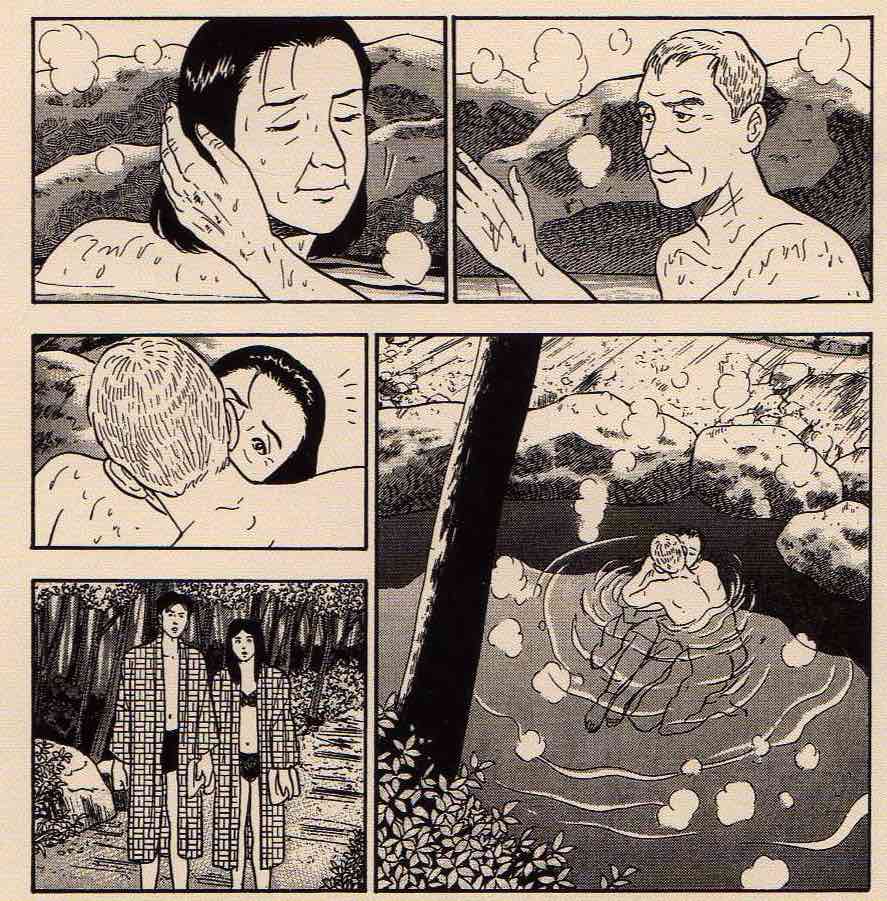
53:20 Interestingly, Shima-san’s imagination is porny, but the actual sex scenes are pretty realistic/standard. This comparison between what he imagines when he’s talking on the phone with Kumiko, and then the actual scene when he and Kumiko make love, is a pretty good example.
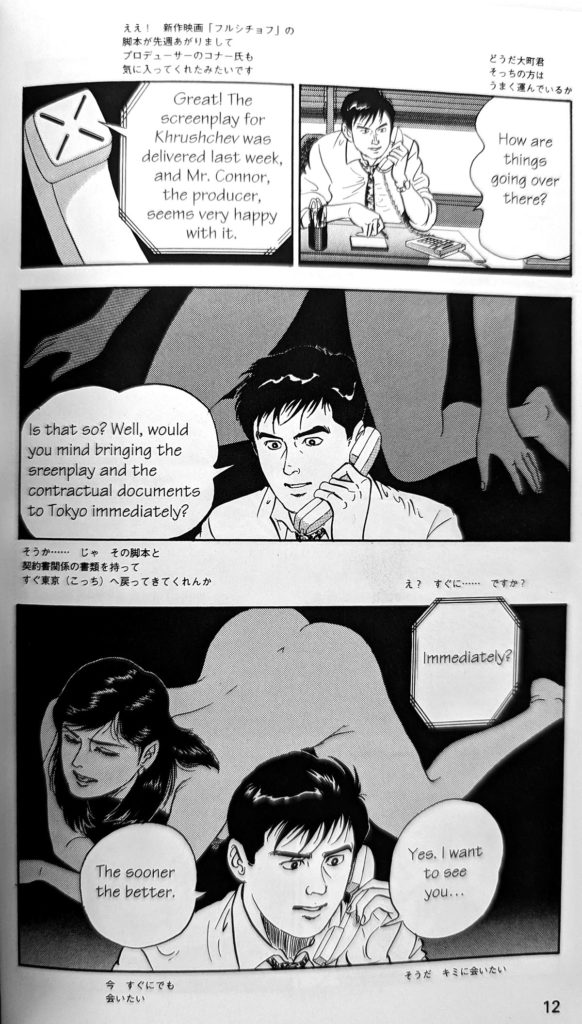
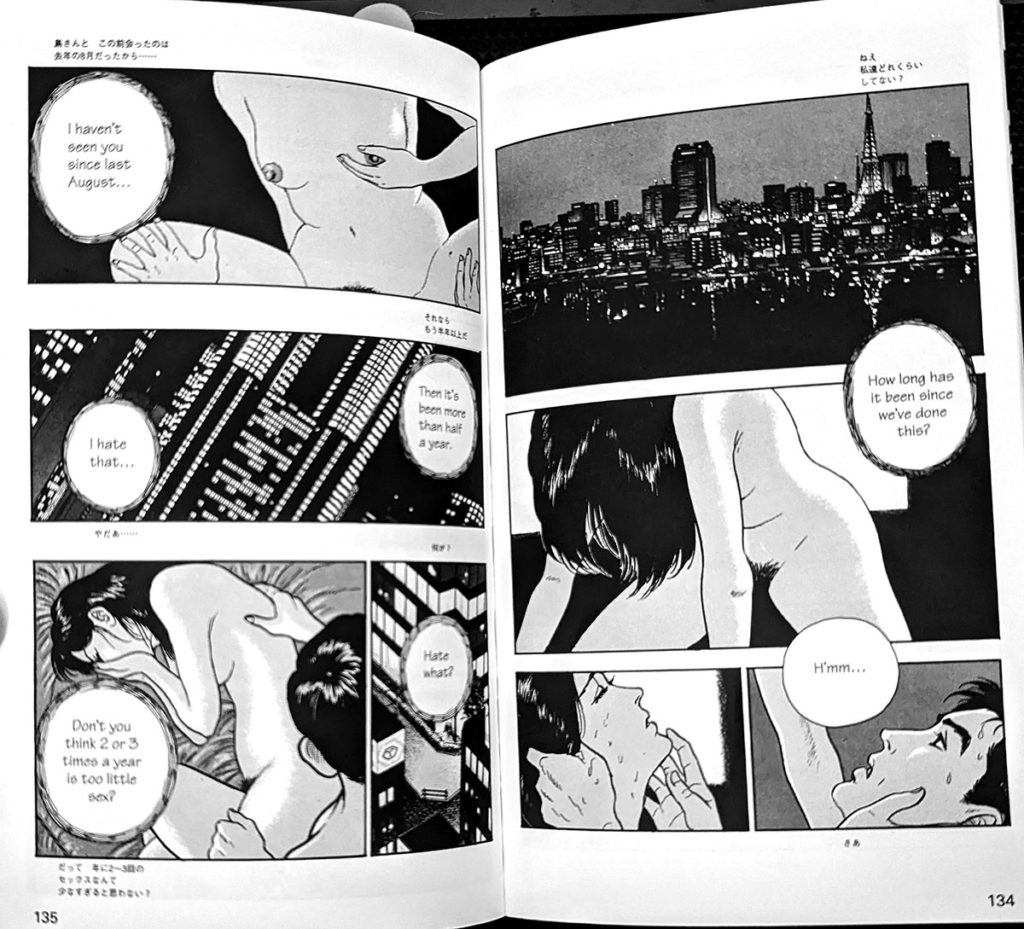
54:40 The unidealized body in this manga is nice, and it dovetails nicely with learning about the middle-aged and elderly love-seeking manga that he’s made. The Salaryman-paunch here, or “Dadbod” as it’s come to be known, is quite well realized, and Kumiko has actual curves too.

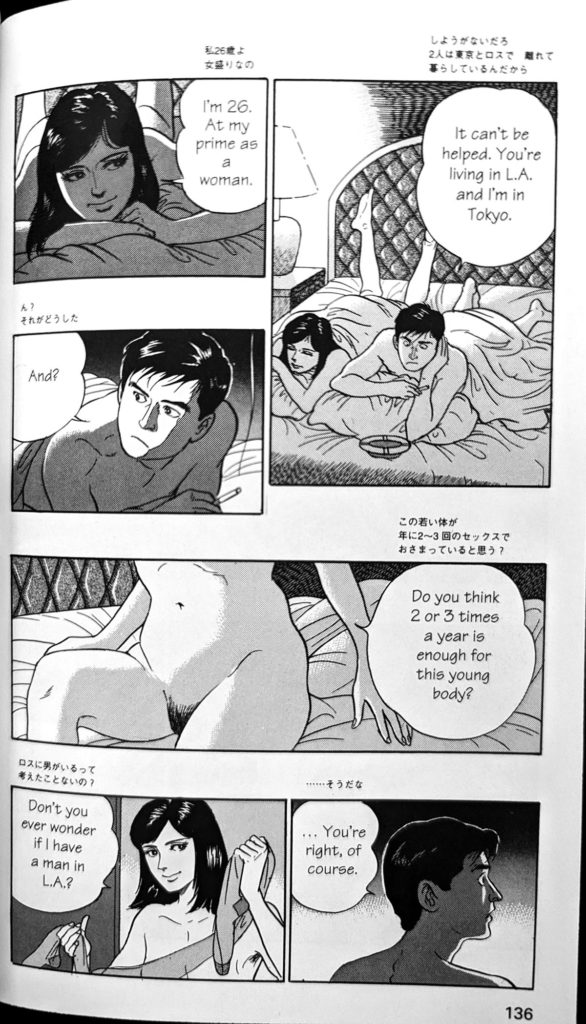
55:23 No idea what’s up with this pantyhose situation though. Yikes.
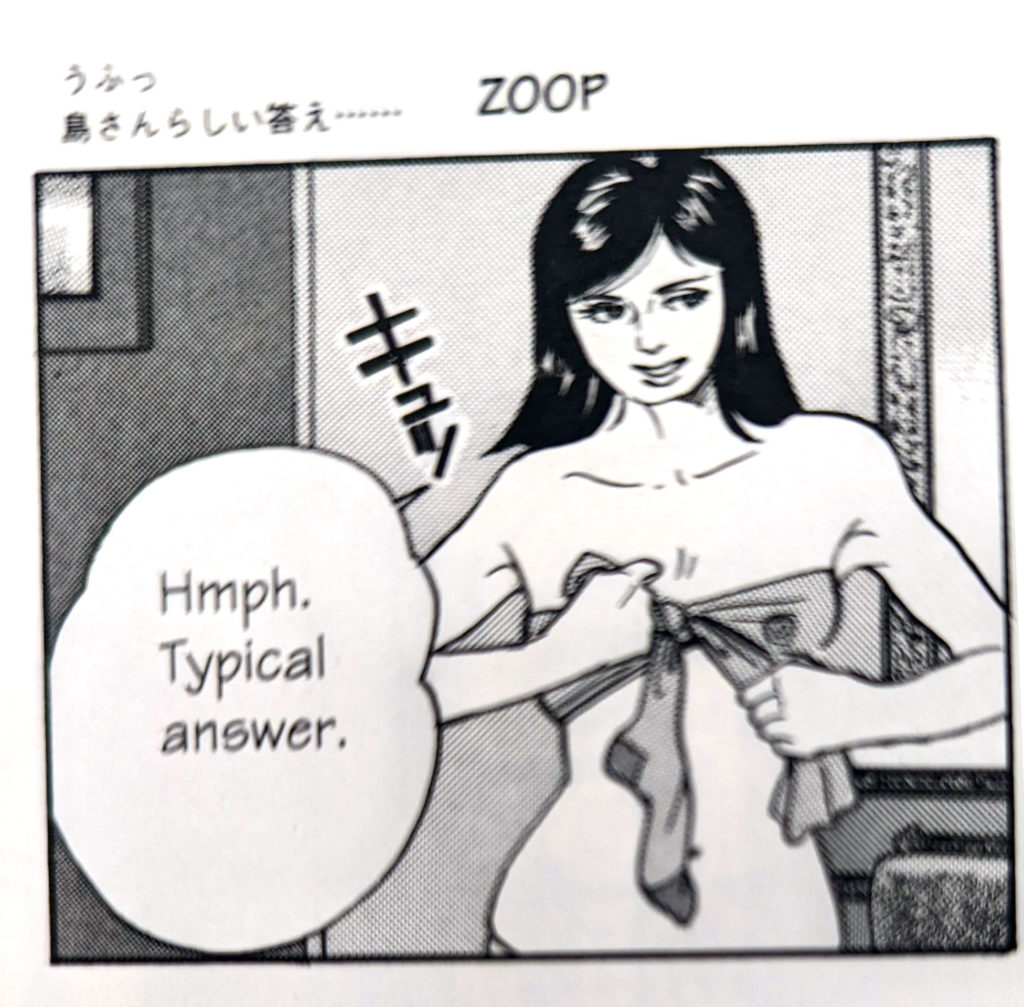
58:55 David with the license to print money, getting Akiko Higashimura to do a life-story series about Kumiko from this book. As you know, Akiko Higashimura created the podcast-fave Tokyo Tarareba Girls, which we’ve talked about a lot on this podcast. Her manga about Tokyo women balancing romance and work (and it’s good too!) gives a pretty good peek at the jetsetting lifestyle of Kumiko traveling between Los Angeles and Tokyo. Man, I’d love to read that one.
Also worth noting, there WAS a female-led spin-off of Kosaku Shima! Section Manager Rinko Kazehana’s Romance is a six-chapter spin-off manga by Hirokane from 2018 that may-or-may-not have been collected (can’t tell), and then was adapted into a two-episode television special which features a female section manager working at Shima’s company.
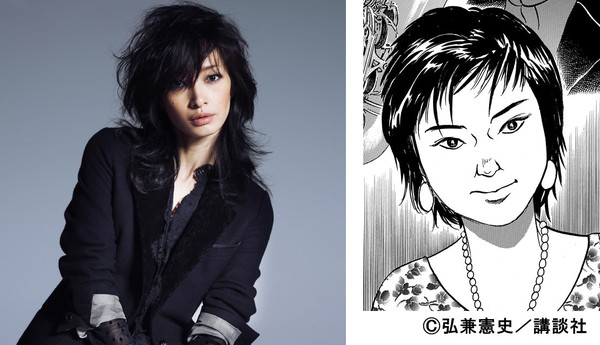
I’d say there’s a lot more potential there, and I love David’s idea.
59:30 Deb mentions the Korean Webtoon A Man’s Man by Dogado and Lucas, and Master Keaton by Urasawa, as being other examples of salaryman comics generally available in English. Christopher jumps in with some of the other Jiro Taniguchi comics including the forthcoming Solitary Gourmet, but if you REALLY want a Salaryman manga, check out The Quest for the Missing Girl, which has a Salaryman whose hobby is mountain climbing need to use his skills to scale the outside of a skyscraper to save a kidnapped young woman. It’s thrilling!
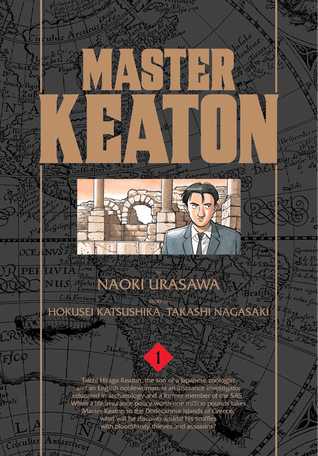

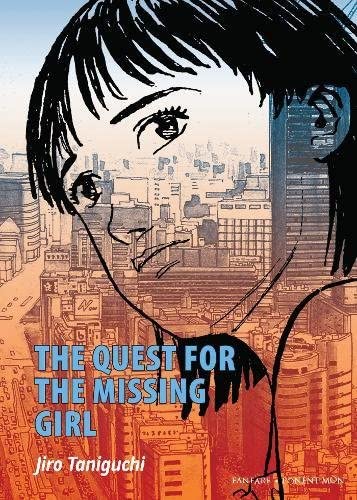
1:01:35 THE BREAK: Hey you’re probably noticing an ad here for Shuna’s Journey by Hayao Miyzaki for First Second. Thanks to them for the sponsorship. Now back to the end of the episode for the shout-outs.
Shout-Outs
Deb shouts-out the remarkable business BL Korean manhwa On or Off by A1, available as a Tappytoon, or in print from Tokyopop. It’s VERY smutty, and if that’s what you’re into, big old honkin’ dongs and all, check this out.
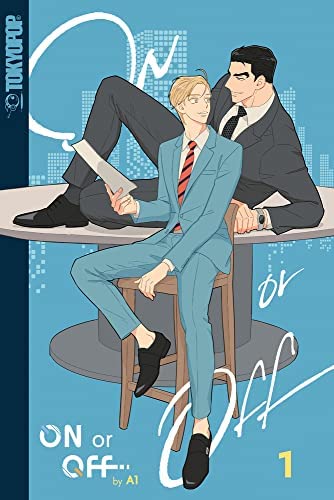
And just an aside here: I think we all know that being a man isn’t about what’s in your pants, necessarily, and ‘man parts’ might not land in the very comical way we intend here. Our bad, and we’re catching-up on how we use language as we go. <3
David’s business shout-out this week is for the business that we call show, and more specifically Michael Bay’s bonkers film Ambulance. This came out in April and I have literally never heard of it, but hey, it looks pretty nuts.
Chip recommends the comics masterpiece Ducks by Kate Beaton, published by Drawn & Quarterly. It’s in stock now over at our friends at The Beguiling in Toronto, or basically wherever there are books.

Finally, Christopher recommends a 2 hour podcast, The episode of Cody Ko and Noel Miller’s Tiny Meat Gang with guest Mr. Beast. If you want to understand what the potential of the Youtube Economy is, alongside some pretty good jokes about-and-by Mr. beast, then by all means, click and enjoy.
And that’s this week in Mangasplaining! This episode is also available wherever you get your podcasts, so please subscribe and leave a review, so others can discover our show.
Also, if you’d like to get the latest episode delivered straight to your inbox along with exclusive interviews, articles and new chapters of manga you can’t read anywhere else, subscribe to our Substack newsletter. See what you’re missing at Mangasplaining Extra!
Next week on Mangasplaining:
We get to the end of the regular season, with Katsuhiro Otomo’s AKIRA VOL. 4.
Thanks so much for listening! Please support your local comic and manga specialty shop when purchasing these books, and you can find one near you at comicshoplocator.com. You can also check your local library for print and digital lending options, they have TONS of manga! Finally, thanks to D.A.D.S. for their musical accompaniment for this episode.

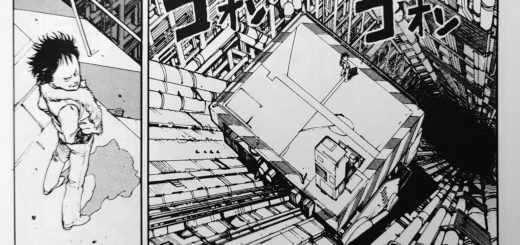
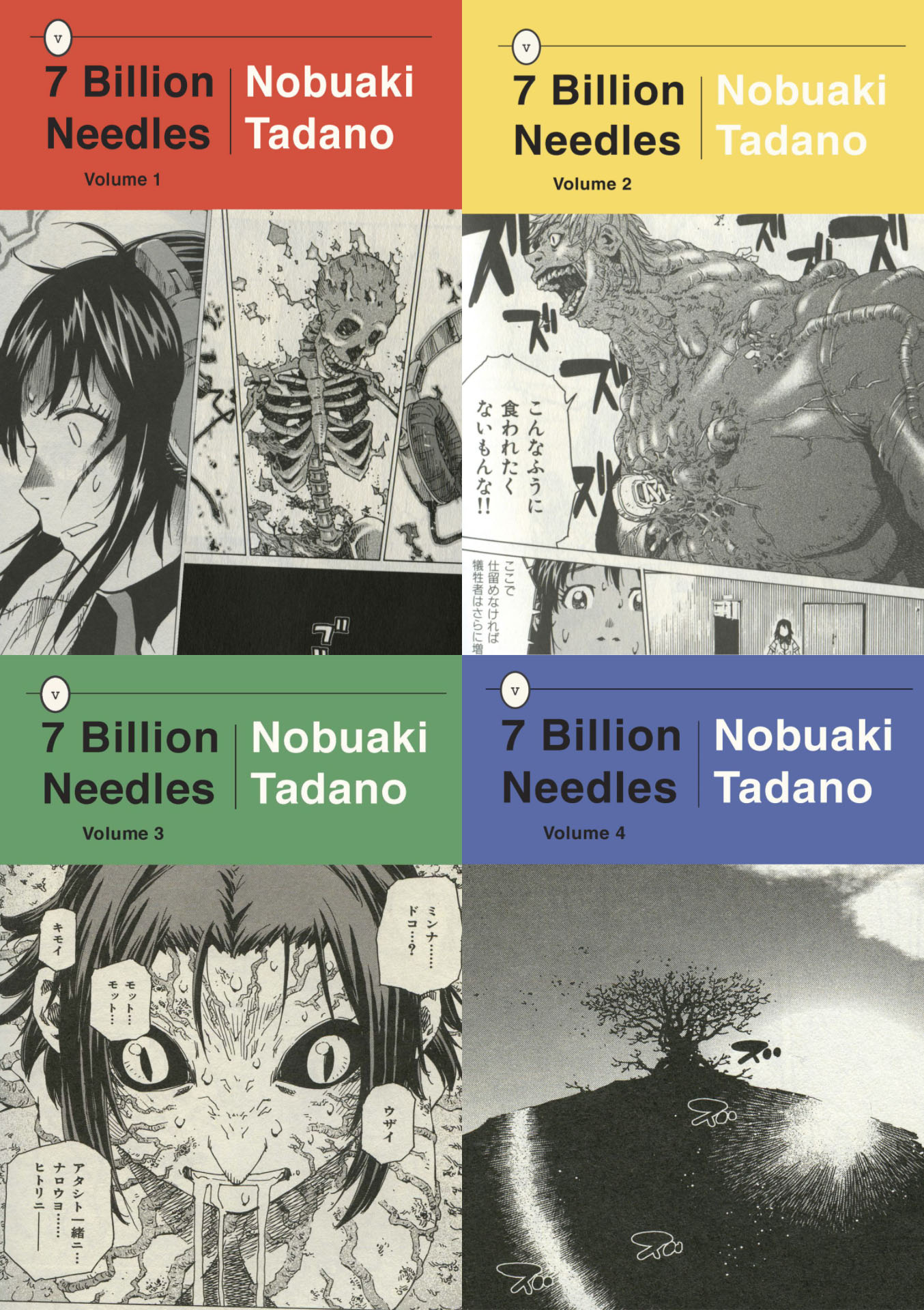
My mom loved Shima Kosaku so I had been buying them for her up until she passed away a few years ago; then after that I just gave up. I just can’t get over how he beds a “different woman” EVERY different chapter/story without getting called out for being a cheating bastard. Some of them are not just much younger but married or engaged too, but he never pays the price, ever! I can normally handle/expect that kind of crazy in seinen say Crying Freeman or Lone Wolf and Cub or gambling manga, but when it happens in Shima Kosaku it just takes me out of the story. I’m not saying cheating can’t be great drama, heck take his mangaka wife the great Saimon Fumi for example (P.S. I Love You, Tokyo Love Story, etc. whose works are criminally untranslated. Come on, people!) Her works may not be about some boring emasculated salaryman, but I keep getting the vibe that these two are bouncing and refracting each other (probably just my imagination), and her stuff are more much agreeable to me. Don’t get me wrong, I love Hirokane, being his “Ningen Kousaten” (Human Crossroads) is one of my all time favorite manga drama anthologies (teared up a few times), but Shima Kousaku just pushes the limit of my credulity… may be I’m just jealous how easy he gets women to go to bed with him… I think the guy has been batting 100 the last 40 years.
The Kodansha Bilingual series were a great way for studying Japanese, but the tiny font size and lack of furigana for the kanji did offer, well, let’s just say challenges. It was always interesting to me how they translation quality ran the gamut from smooth competence to dogged literalism. I remember the GTO editions translated “senkou,” a derogatory slang term for a teacher, as the English word chalkie, which kind of robbed the term of the vehemence the students uttered it with. I think the translation used for “yankii” was “young turk” which certainly was a choice, and a pretty dated one at that. Some translation peculiarities aside, it was a huge sense of accomplishment to graduate to the full-on Japanese series once I had exhausted the available bilingual editions.